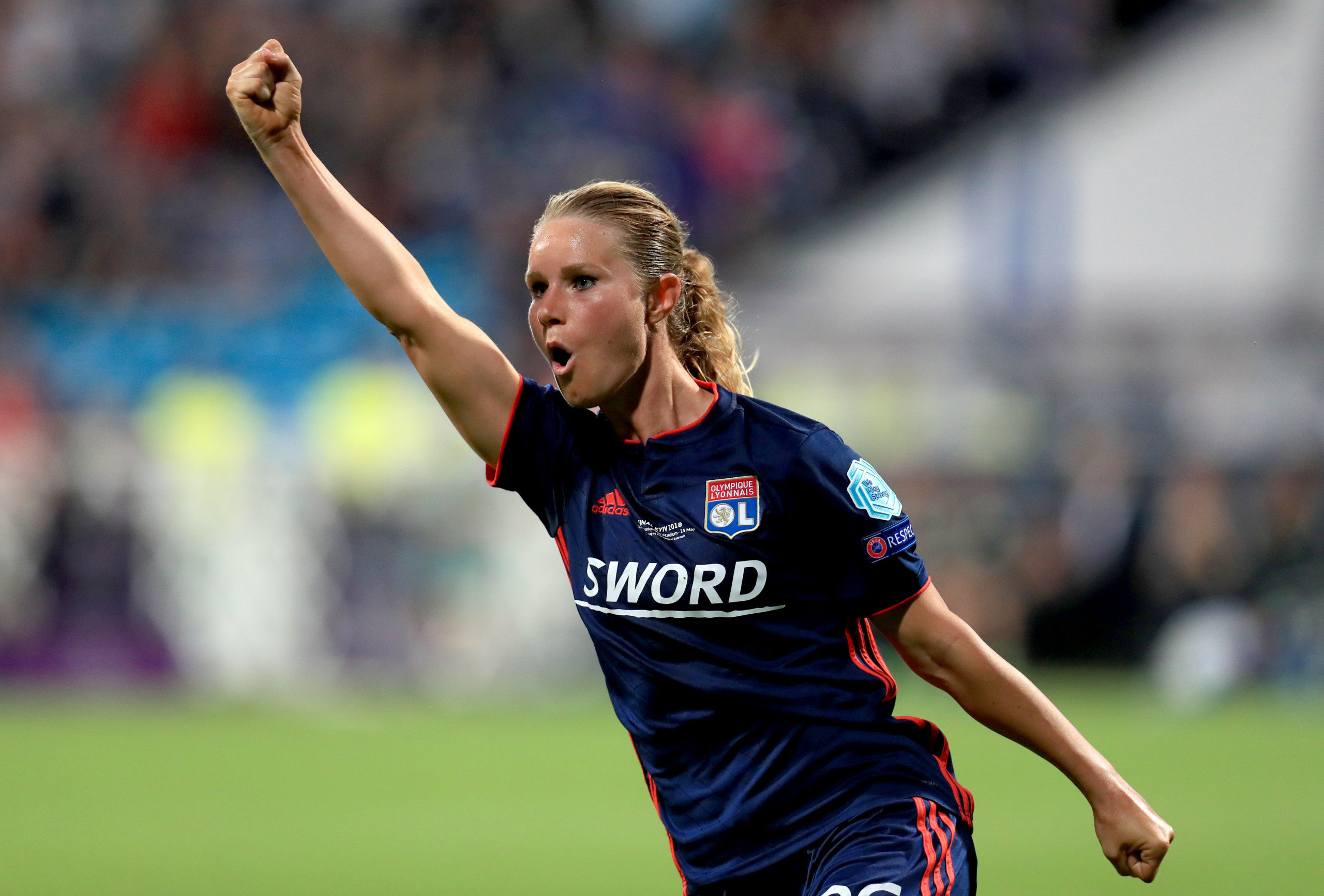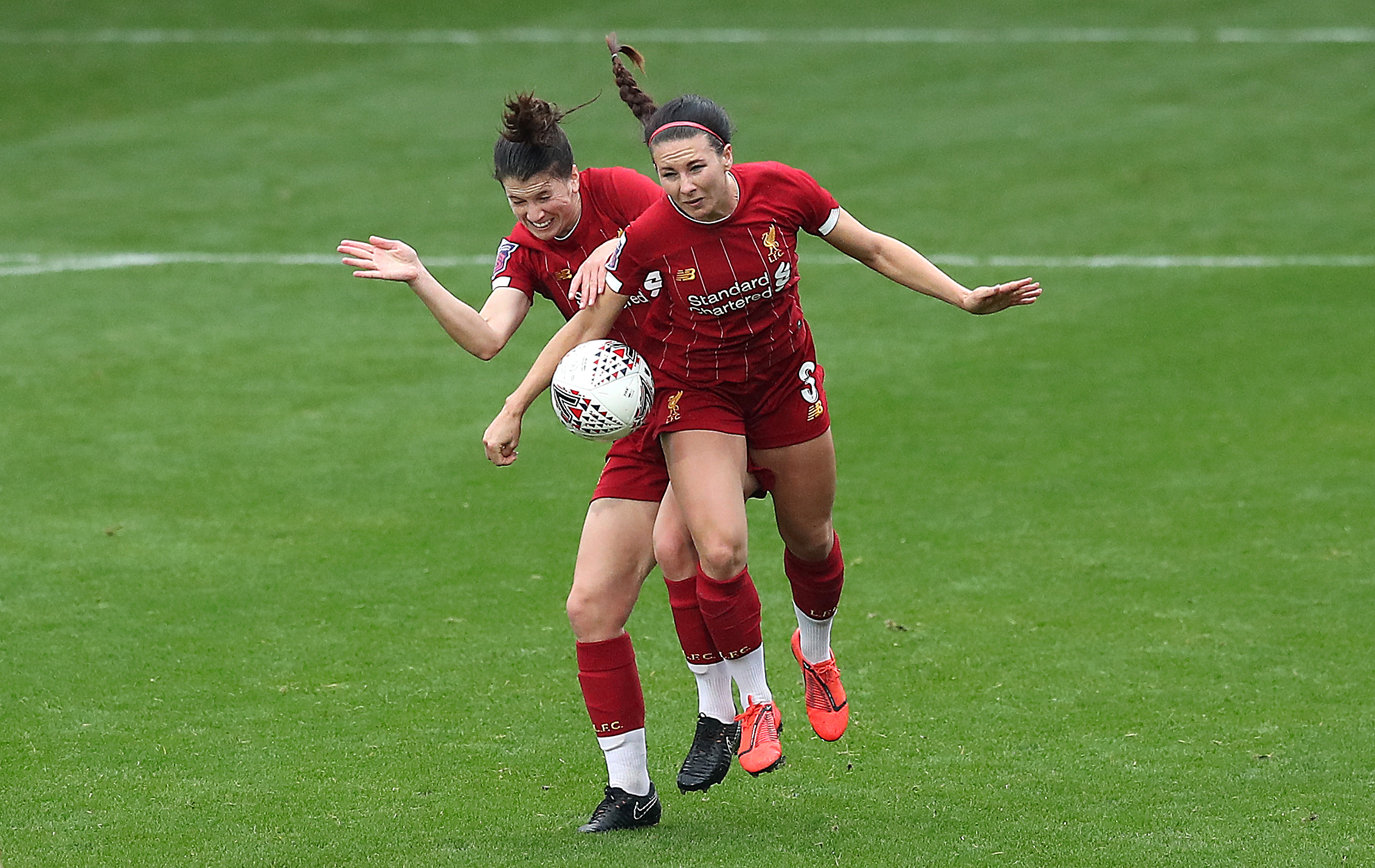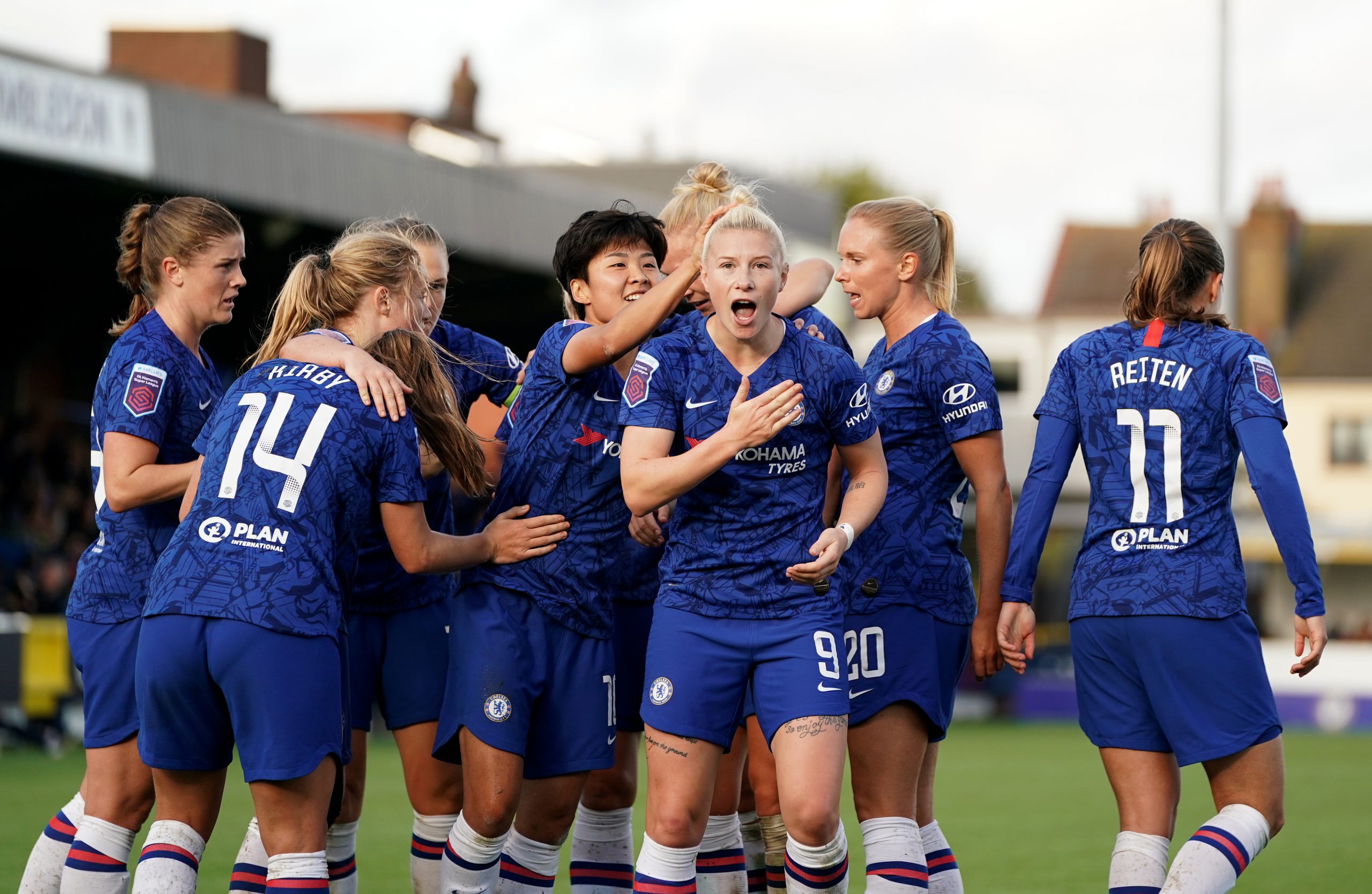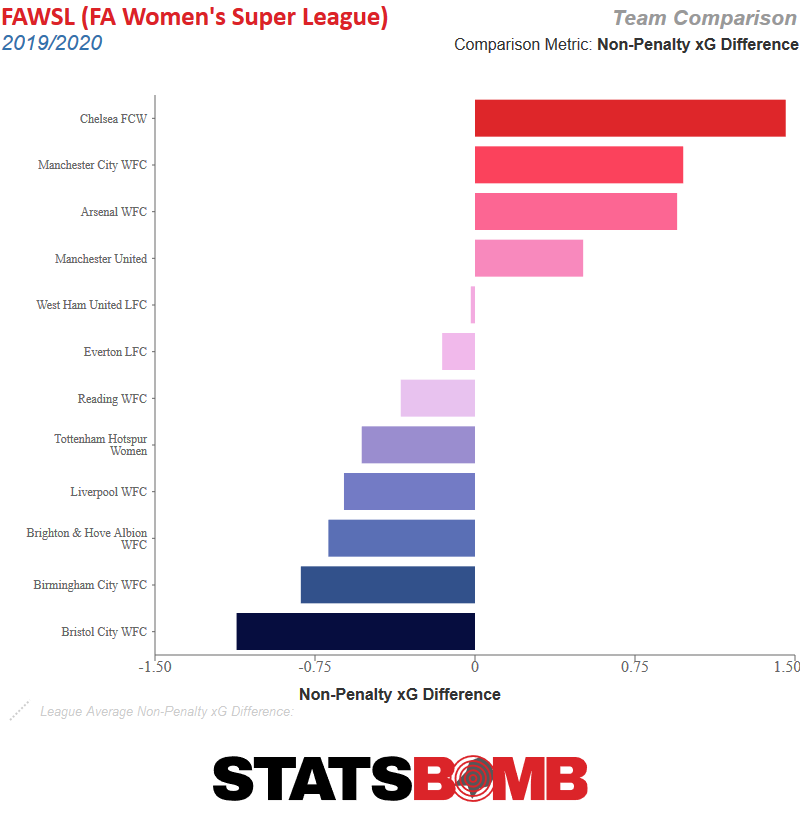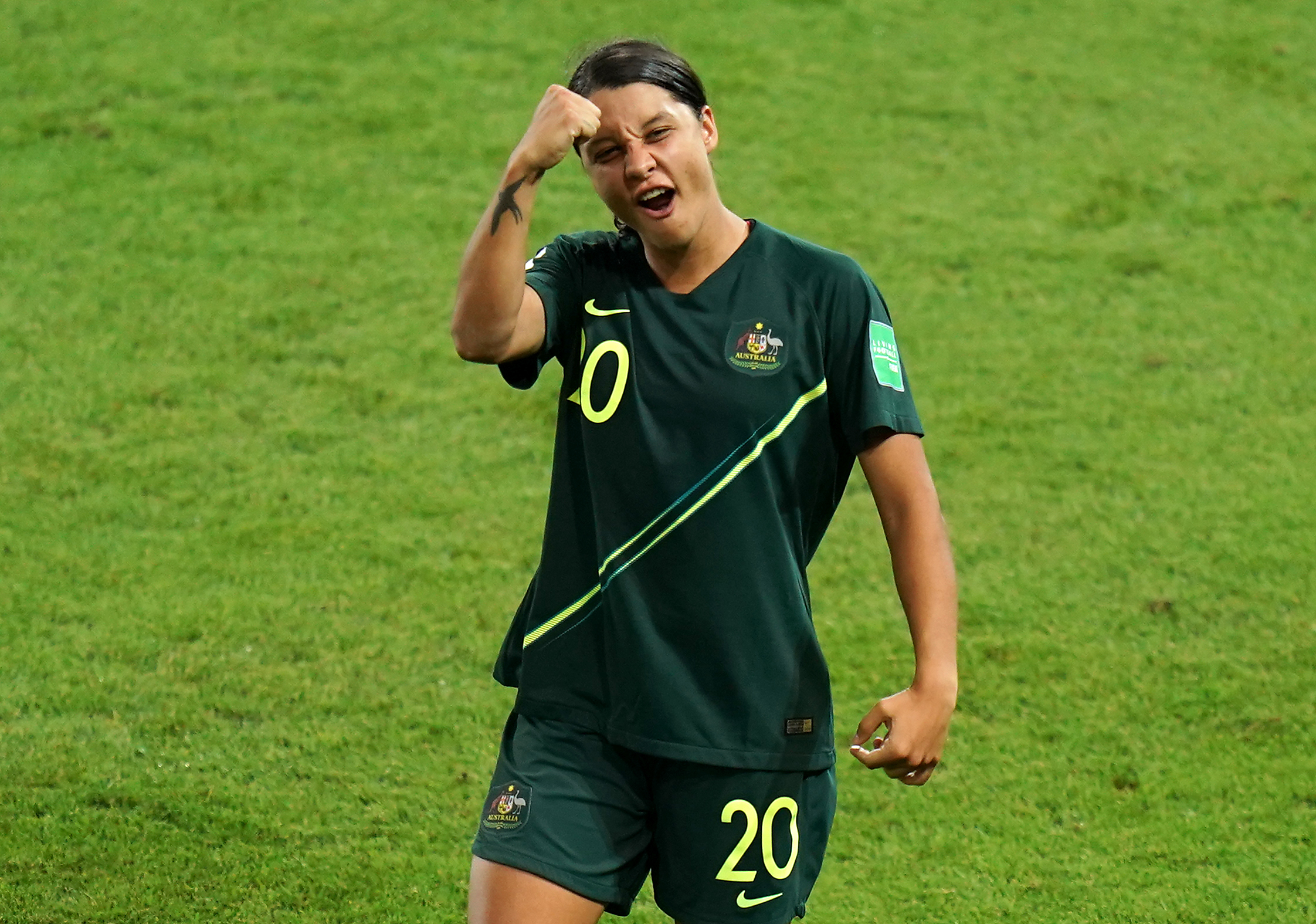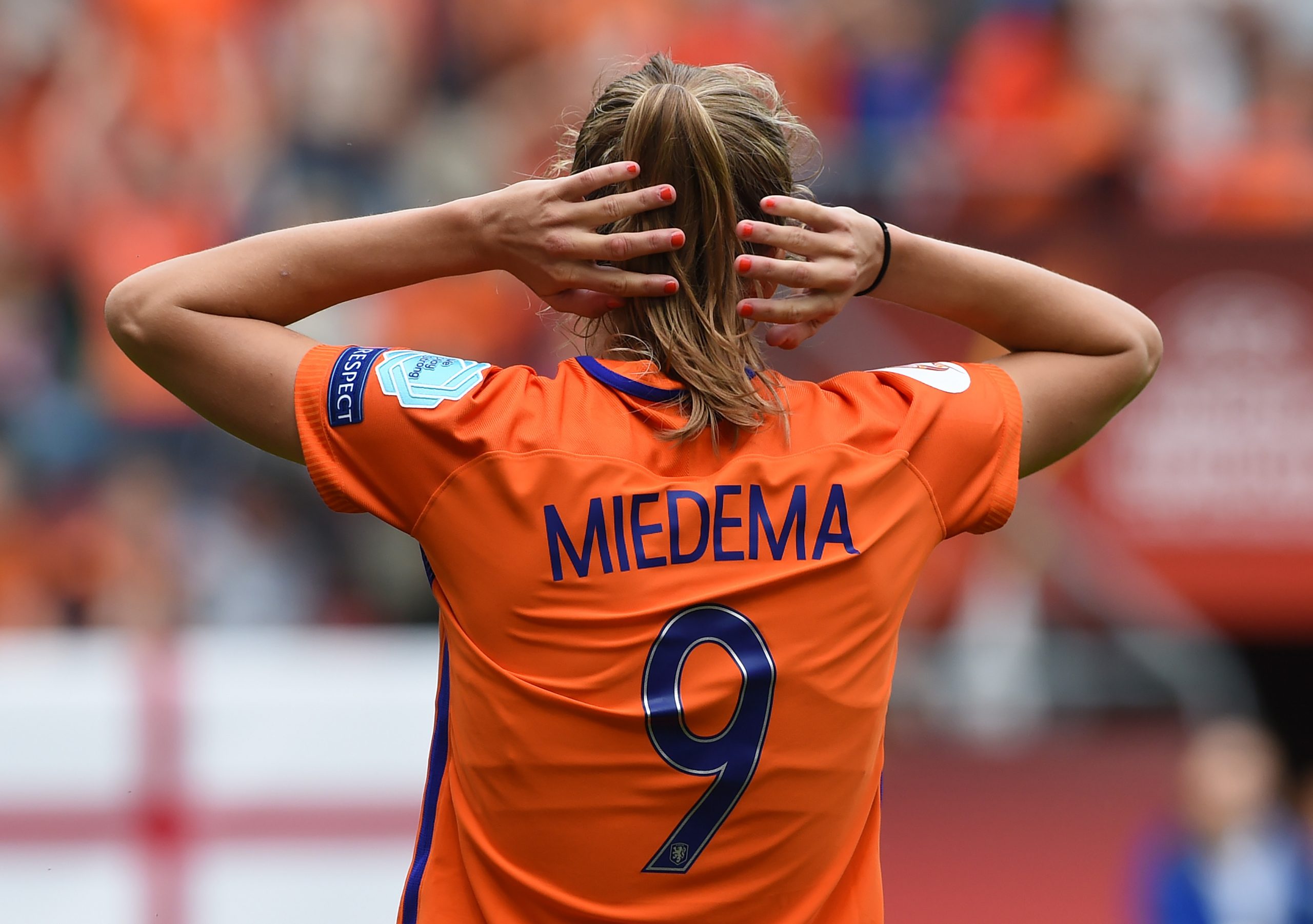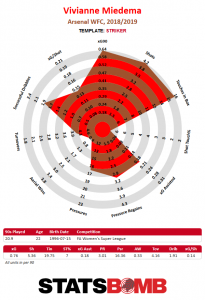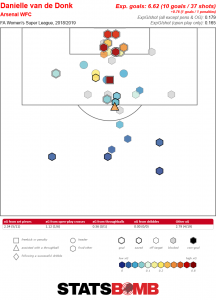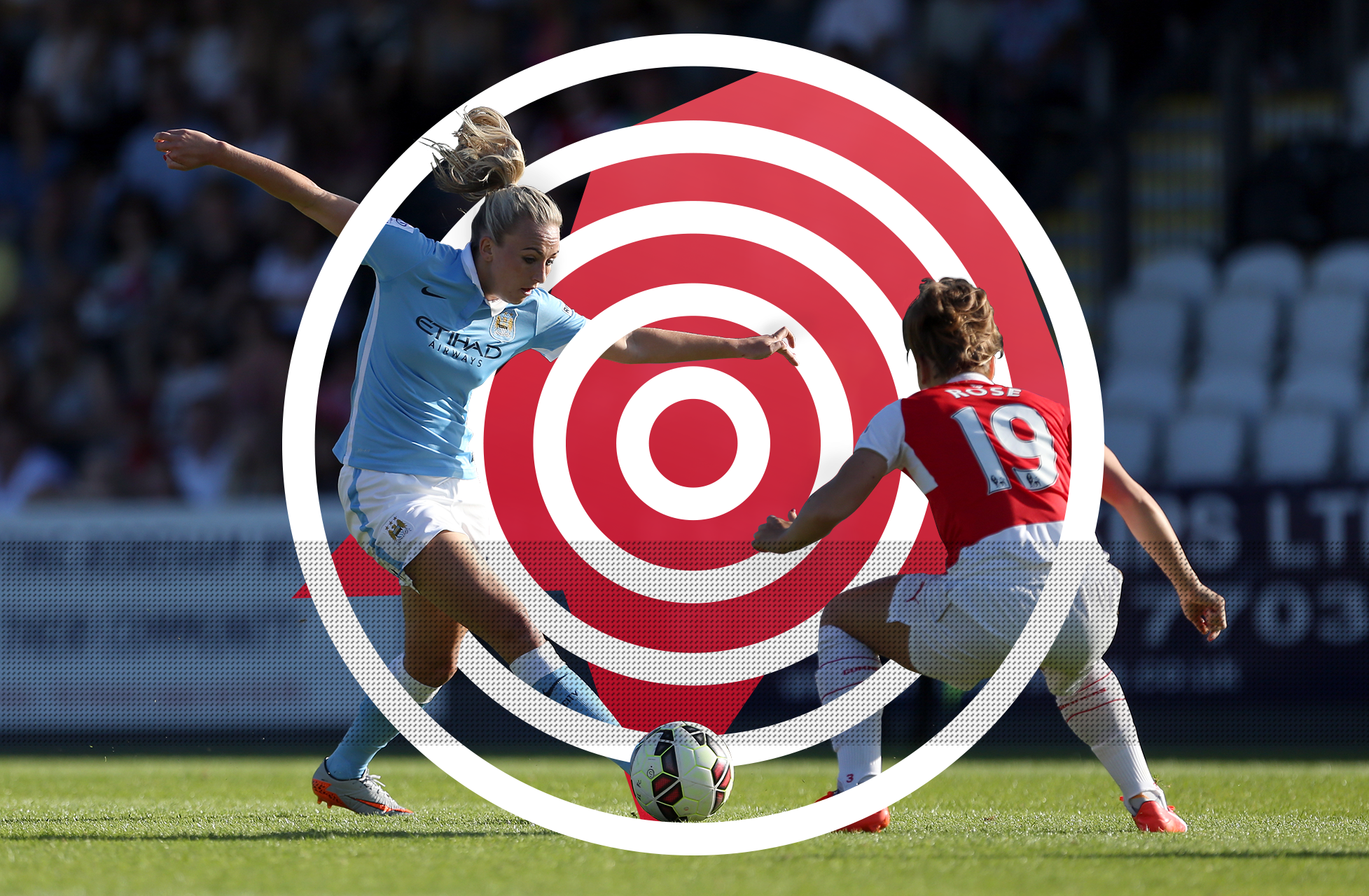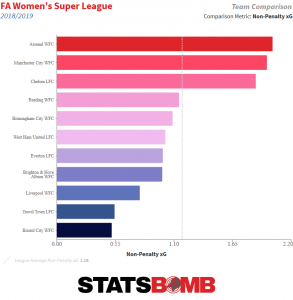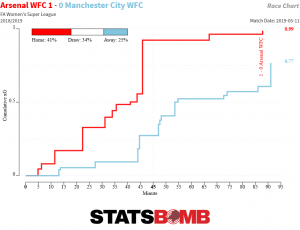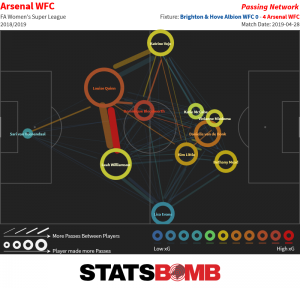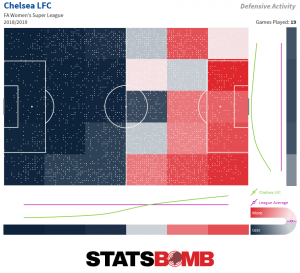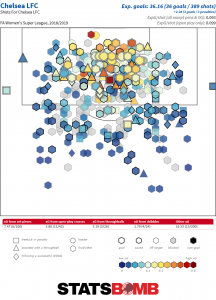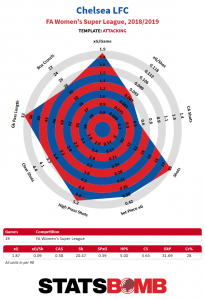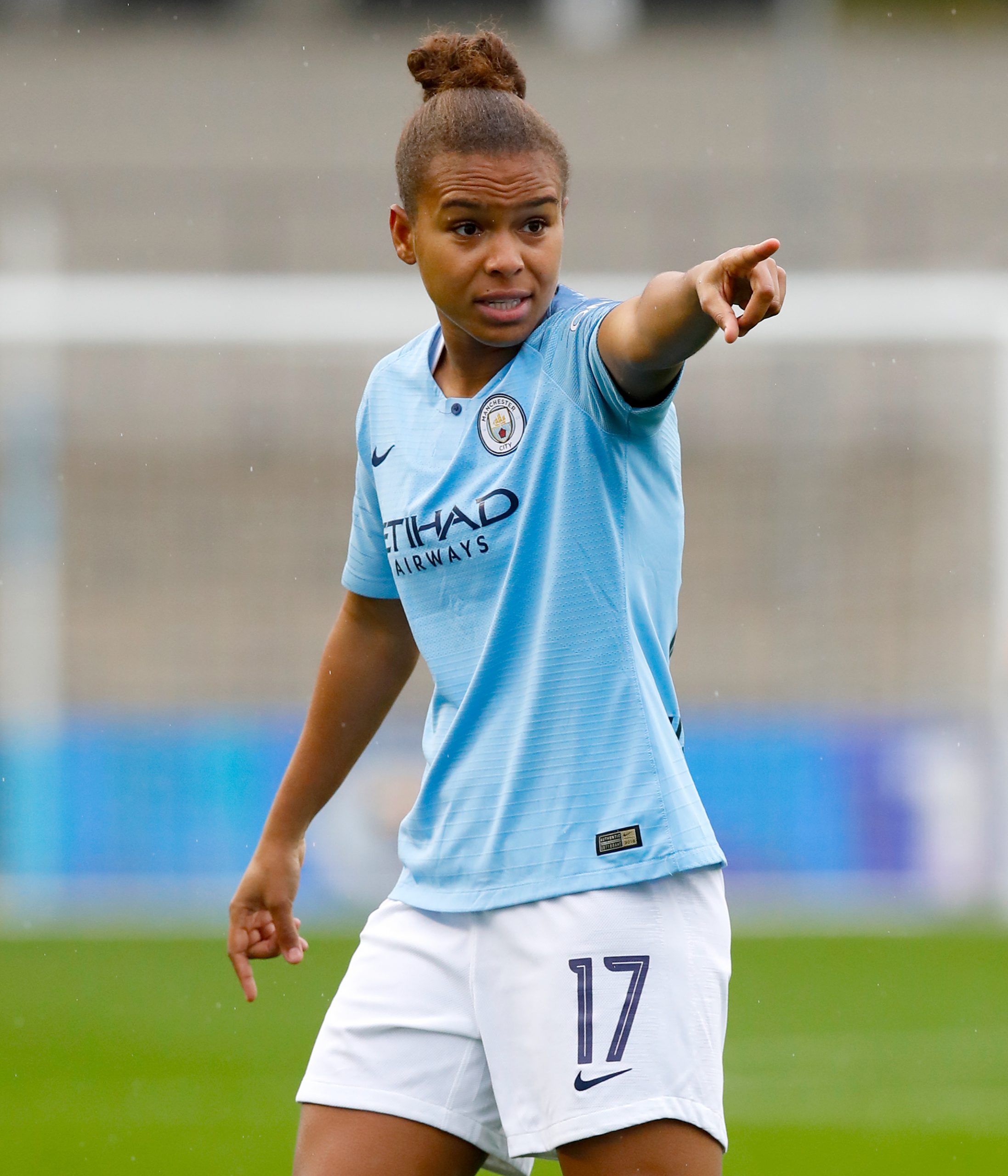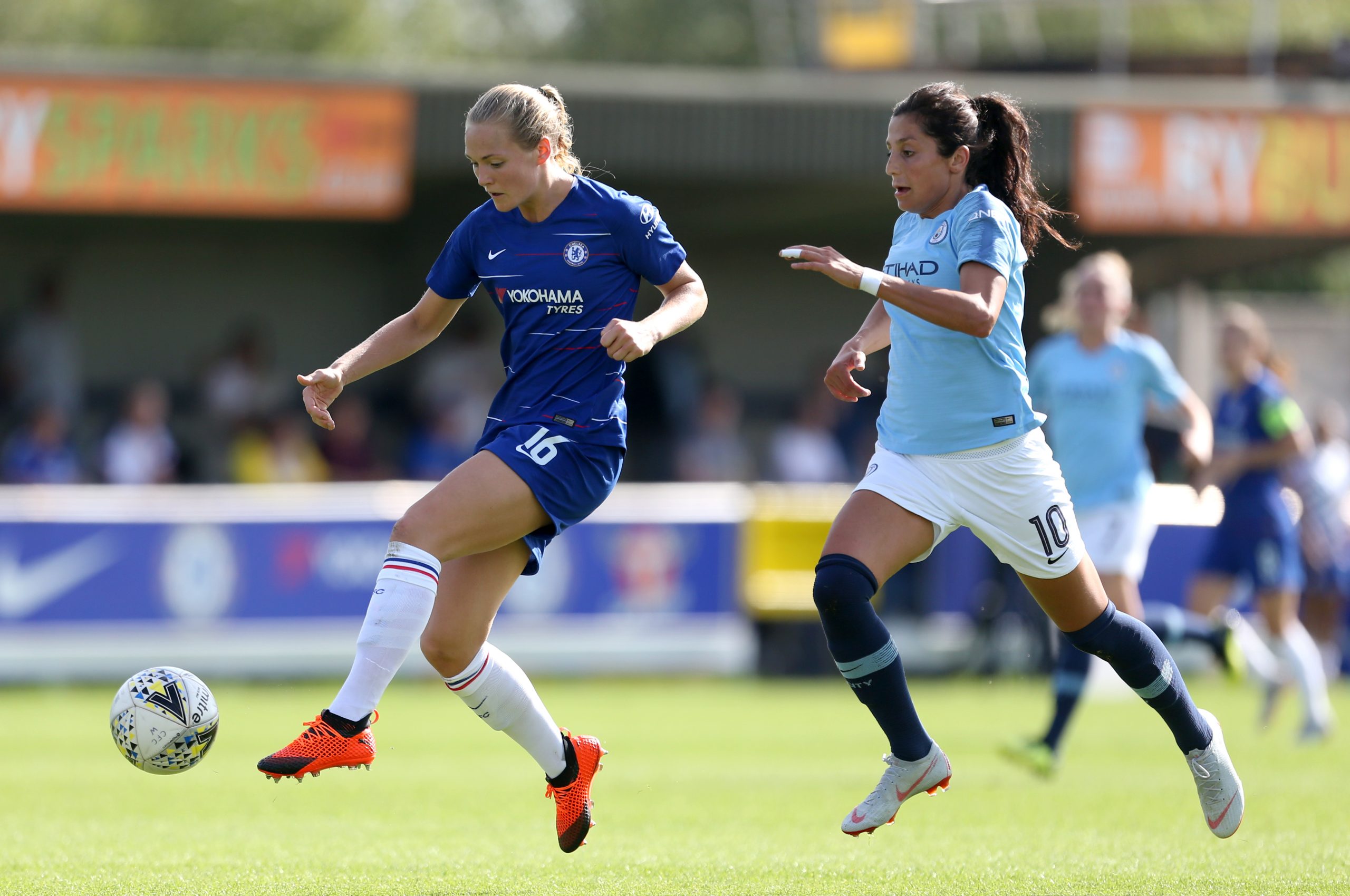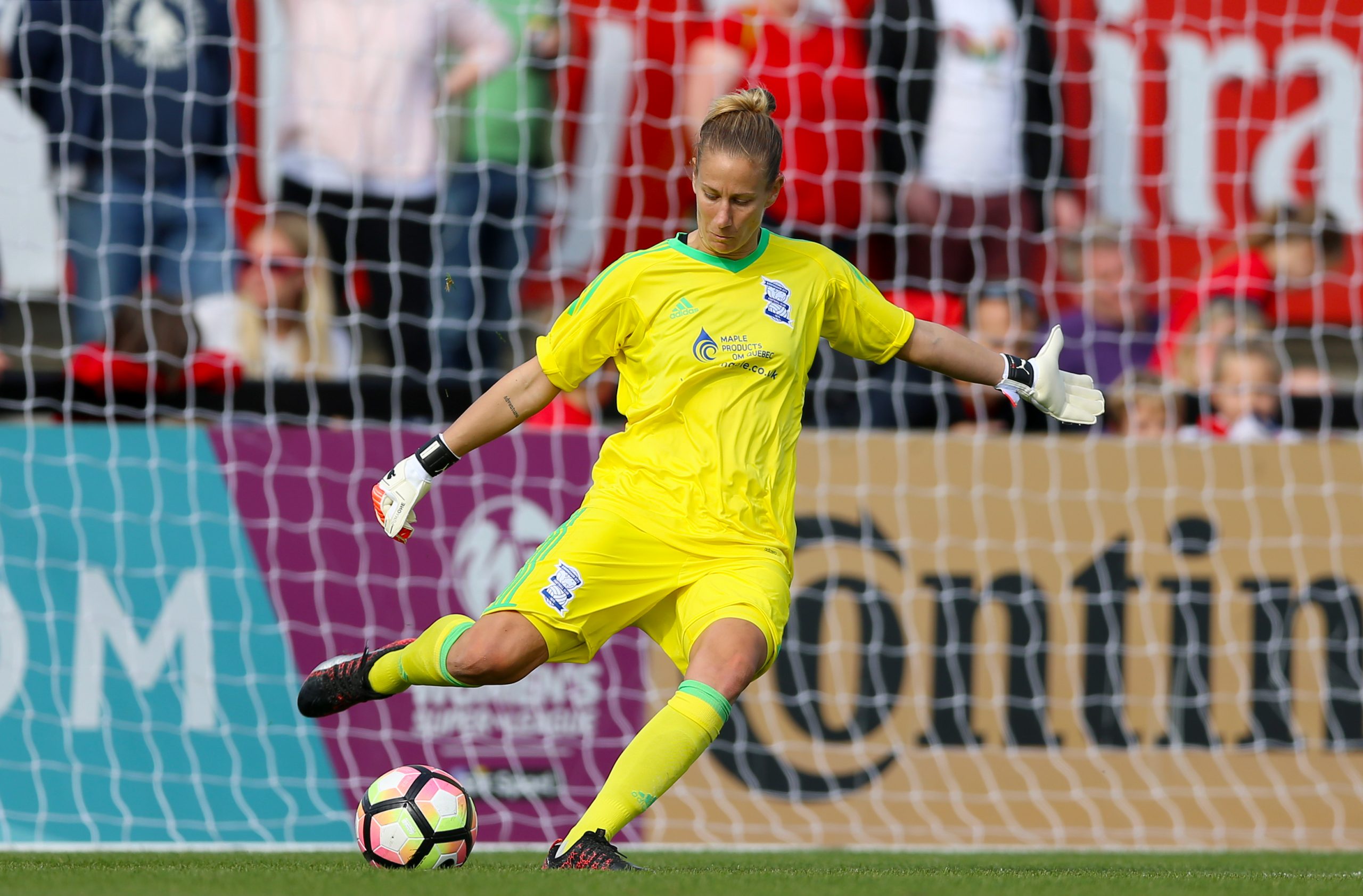An equal playing field is important to StatsBomb. We continue to look for new ways to support the acceleration of the Women’s game globally and as part of our commitment to International Women’s Day, we are opening up access to our 2019-20 and 2020-21 French Féminine data and analytics for FREE to all the teams in that league. Back in 2018, we wanted to propel knowledge of the Women’s game and offered our industry leading, quality data specification for a selection of Women’s leagues for free. This was alongside tuition resources, support and advice to help boost the application of data analysis in the Women’s game. It is exciting to see analysts, bloggers and fans creating analysis, data visualisations and gifs all entirely focused on Women’s football, especially where StatsBomb’s detailed data spec provides unique insight into pass footedness and defensive pressure activity that is not available in the public domain for the Men’s game. However, we recognised there was more we could do to remove barriers in the Women’s game and help the clubs themselves use data and analytics to enhance performance. As our quality data and insight can help drive improvements on the pitch, we needed to address barriers around cost and expertise experienced by Women’s teams. So in 2019, all FAWSL Women’s teams were offered free access to our analytics platform, StatsBomb IQ, along with all the detailed statistical modelling for the FAWSL 2019-20 season. Most of the teams have taken up the offer and have integrated data analysis into their internal processes across tactical match analysis and opposition analysis. We have also been working more closely with English Women’s teams in applying data and insight to develop coaching practices. This year, our ambitions are to increase inclusion in other European leagues, so we are excited to announce that we are offering FREE 2019-20 and 2020-21 data to all France Féminine teams. This includes completely free access to our industry leading analytics platform, StatsBomb IQ and training in using the platform. The platform is designed to be intuitive, easy to navigate and enables real practical insight. Whether comparing overall team performance on key metrics, evaluating players or reviewing matches, StatsBomb IQ enables a complete, one-stop solution for use from the pitch to the boardroom. We are hoping that by making our platform available from now through the 2020-21 season and giving free training from our highly experienced analysts, France Féminine teams can enhance their pre- and post-match analysis workflow. Continuing our ambitions to ensure that Women’s football does not miss out on the data revolution that is happening in the Men’s game.
There comes a time for any team where the number of points you’ve managed to accumulate in a season has gone beyond frustrating to just embarrassing, where opposition fans are looking at you in sympathy and speaking in hushed tones reserved for funerals, where conversations are entirely focused on what’s going wrong because there’s nothing else to focus on. But as the great football commentator and hobbyist poet, Robert Frost, declared, “Sometimes the coverage of teams in crisis—much like roads in a wood—diverge and we should really take a look at why”. How do you quantify a crisis, though? A team underperforming on their expected goals in every game of the season probably is cause for some consternation. A team that consistently loses possession and concedes goals without scoring any of their own should raise alarm bells. A mid-table team slipping to the bottom of the league would likely warrant concern, but maybe not as much as a team that routinely finishes in the top four doing the same. When a team that’s won the league twice in the last decade is firmly in last, with a single goal and a single point to their name, we’ve probably moved past concern and are sitting firmly in crisis territory. So why isn’t anyone wringing their hands over Liverpool Women? There’s really no arguing that Liverpool Women are in dire straits. In their last eight matches, they’ve managed to score one goal (a penalty) in the only game in which they picked up a point. The stark differences in trendlines for expected goals and expected goals conceded this season do nothing to assuage the panic or convince us that this is “just a slow start to the season”, especially because there’s no sign that the club believes there’s any cause to panic (we’ll come back to this later). 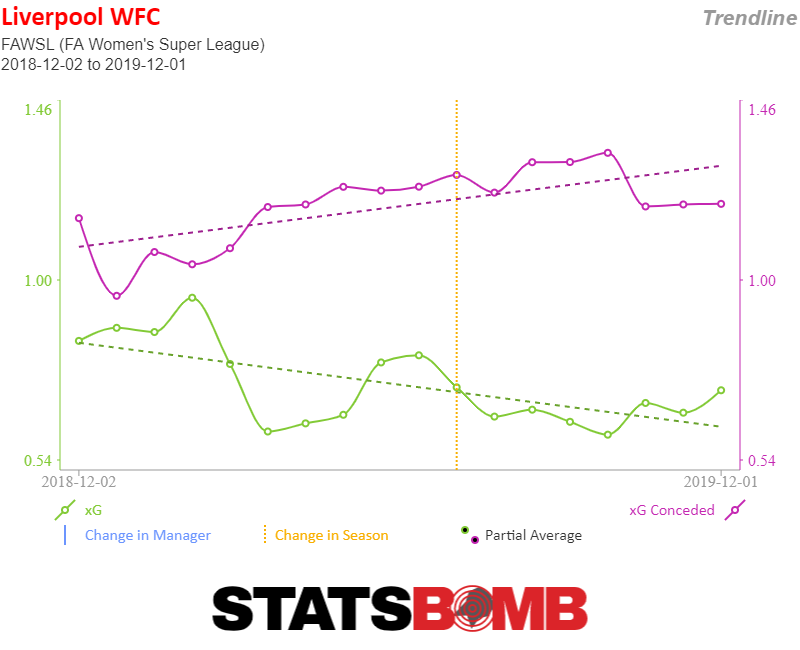 It’s difficult to pinpoint what exactly has gone wrong for Liverpool Women over the last two seasons because there’s just so much terribleness to choose from. Take the most basic aspect of scoring a goal: it’s not like Liverpool aren’t taking shots. It’s that the shots they’re able to take are either off-target or relatively easy to save.
It’s difficult to pinpoint what exactly has gone wrong for Liverpool Women over the last two seasons because there’s just so much terribleness to choose from. Take the most basic aspect of scoring a goal: it’s not like Liverpool aren’t taking shots. It’s that the shots they’re able to take are either off-target or relatively easy to save. 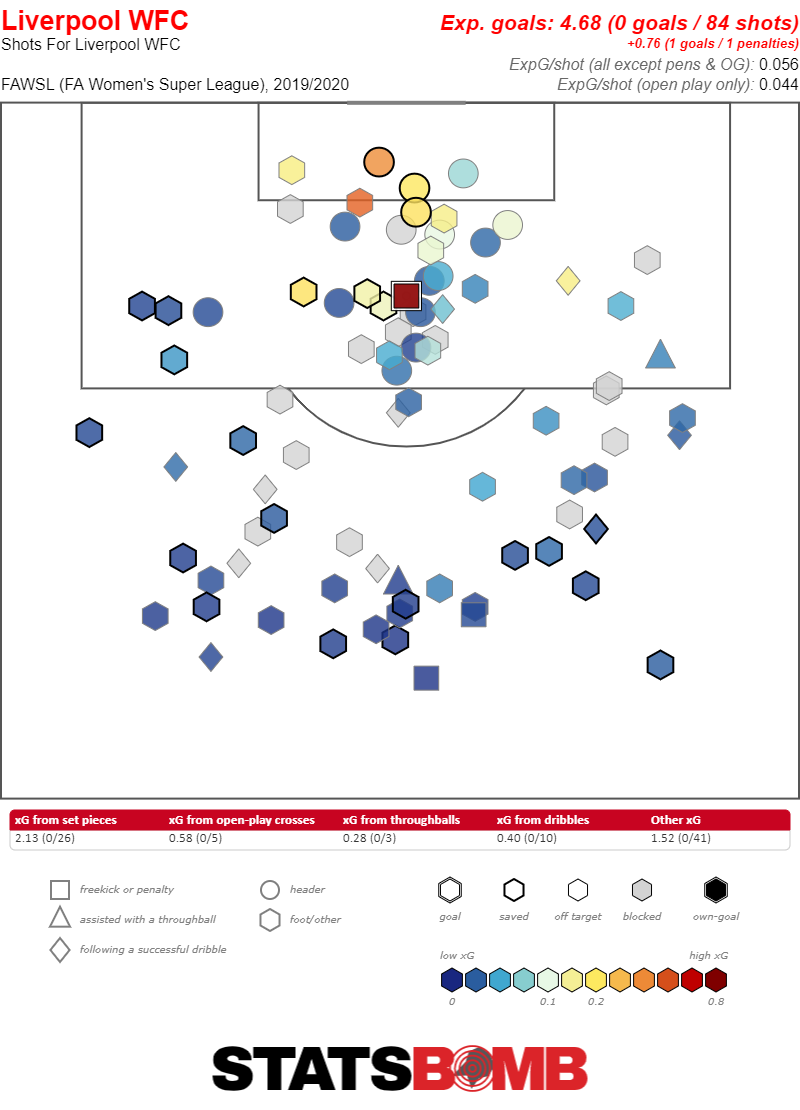 The few shots with a higher xG than 10% saw the opposition goalkeeper close to optimal position, as well as several opposition players in place to prevent scoring on a rebound. More than that, though, Liverpool strikers have rarely found the support they need in the box. Even the one exception this season fell short: Kirsty Linnett’s shot on goal against Birmingham forced an excellent save from Hannah Hampton and Rhiannon Roberts was quick to take a shot again from the rebound. Both shots caught Hampton just out of optimal position, but neither were able to actually score.
The few shots with a higher xG than 10% saw the opposition goalkeeper close to optimal position, as well as several opposition players in place to prevent scoring on a rebound. More than that, though, Liverpool strikers have rarely found the support they need in the box. Even the one exception this season fell short: Kirsty Linnett’s shot on goal against Birmingham forced an excellent save from Hannah Hampton and Rhiannon Roberts was quick to take a shot again from the rebound. Both shots caught Hampton just out of optimal position, but neither were able to actually score. 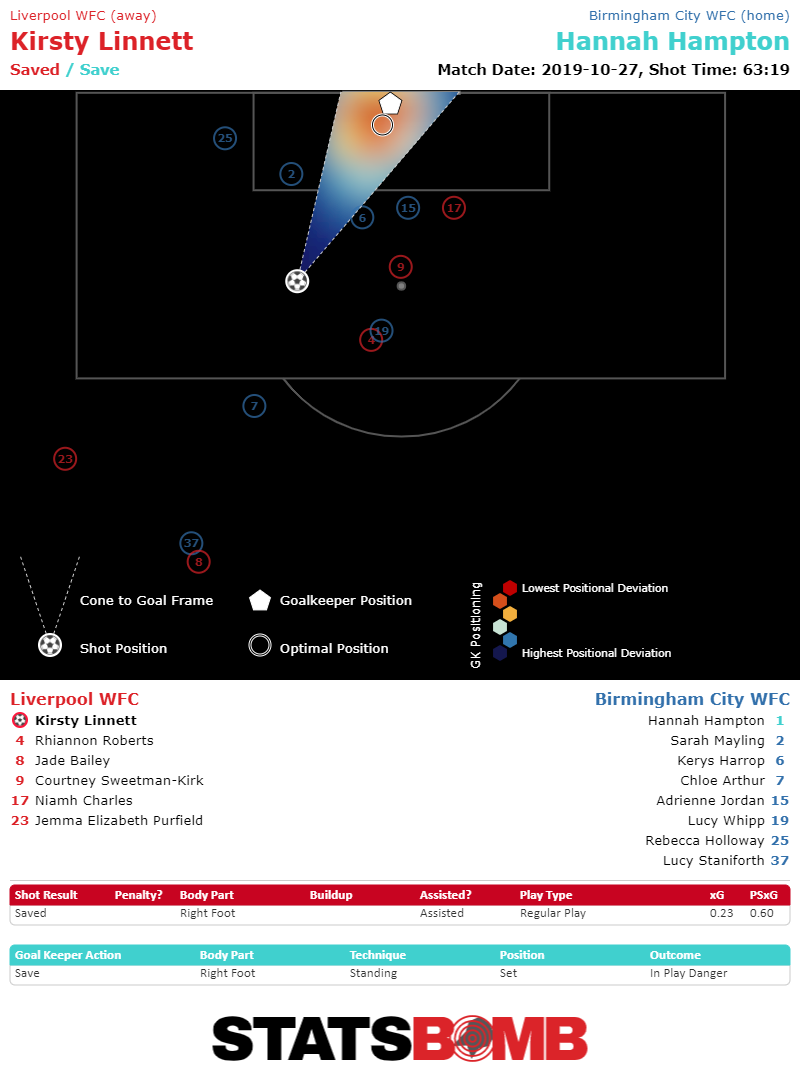
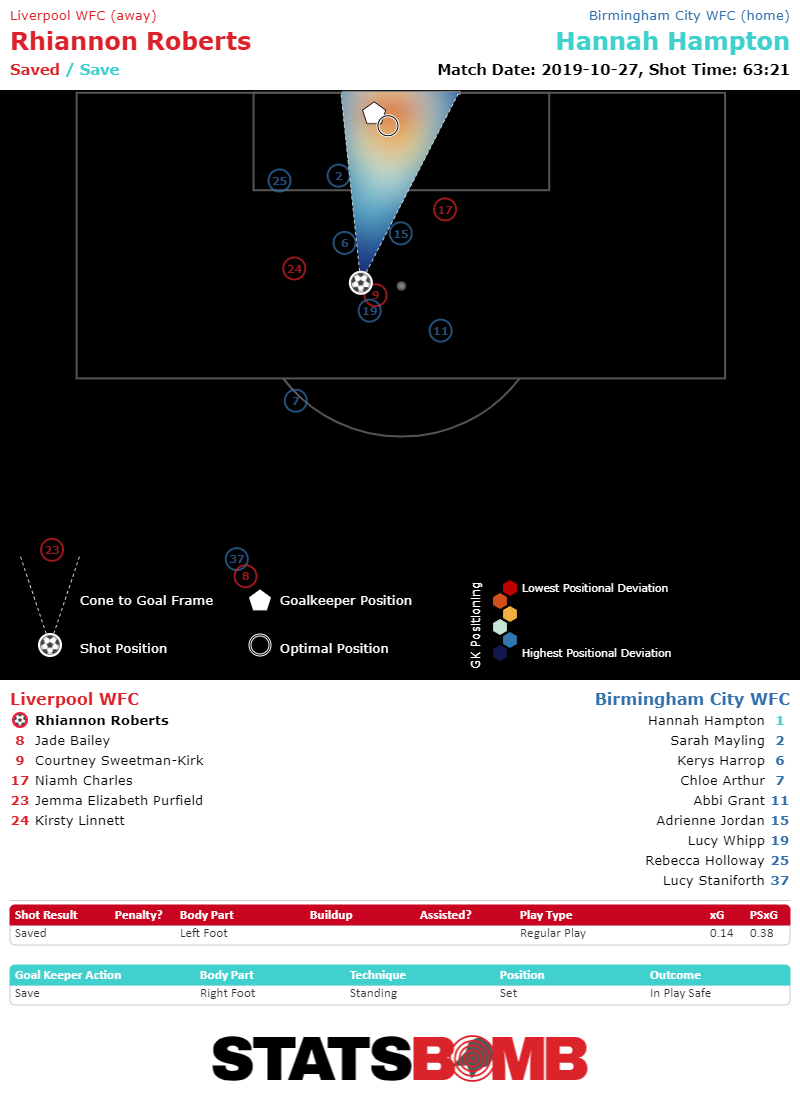 So, while it’s true that Liverpool are underperforming against expectations, it’s also true that the shots they’re generating are simply not good enough. Even the club’s top goalscorer hasn’t been able to find the back of the net. And despite Liverpool being excellent at putting pressure on opponents and better than average at pressuring ball-holding opponents to win the ball, they’ve yet to see a single clean sheet in the WSL this season.
So, while it’s true that Liverpool are underperforming against expectations, it’s also true that the shots they’re generating are simply not good enough. Even the club’s top goalscorer hasn’t been able to find the back of the net. And despite Liverpool being excellent at putting pressure on opponents and better than average at pressuring ball-holding opponents to win the ball, they’ve yet to see a single clean sheet in the WSL this season. 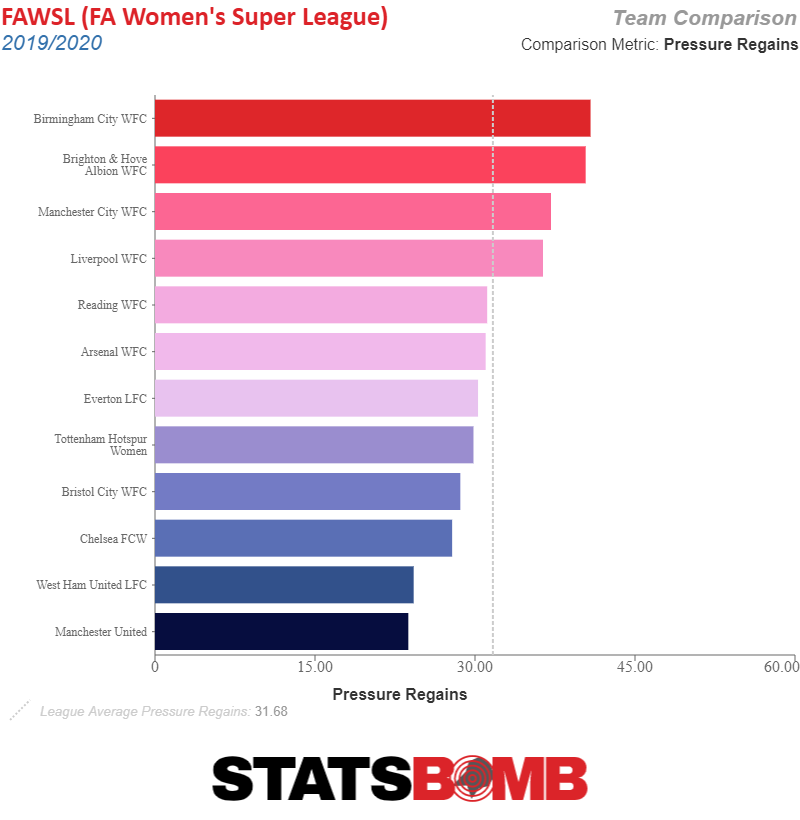 At this point in the season (again: eight games in, one goal scored and one point gained), surely it’s time for a conversation on what exactly needs to be done to make the ball go into the net. Because here’s the thing: if something doesn’t happen pretty soon, Liverpool Women are going to be relegated to the Championship. And for a club that’s gone on (and on and on and on) about how this is one club and two teams, it won’t look great when the men’s side have been given absolutely everything they need to win the league and maybe retain the Champions League title, too. Those of us that do regularly wring our hands over Liverpool Women and just how terrible everything is have a laundry list of very simple requests (we also have a support group). We’ll take anything from investing just a tiny bit more money into the club (we’re not asking to be in the running to sign Sam Kerr but maybe a coach with some ideas about creating better chances would come in handy at this point?) to allowing the women access to the same training facilities at the men. The fact that Liverpool Women’s fans have to beg for basic resources that the club already has is particularly egregious when you look at every other big club and the amount they’ve invested into their women’s teams. Want to see how effective investing resources into a women’s side can be? Take a look at Manchester United Women, a newly promoted team coached by a former Red and featuring several former Liverpool players who are absolutely thriving at a club that is supporting them. And at the end of the day, that’s the real crisis here. Somehow the level of panic and agitation we see when teams like Arsenal Men or Everton Men start losing games, when they consistently underperform, when their star players start talking about leaving the team, just isn’t present in conversations about Liverpool Women. We’re not seeing any mainstream critical analysis of where the team is falling short. At some point the conversation needs to move beyond demands to support the team despite their struggles and rather towards the well worn sporting topic of what should be done to fix those struggles. Liverpool Women are a professional football team that are in a bad situation, but not an irreversible one. Treating them as anything but is doing them a disservice. A lack of discussion could well lead to relegation, and even more players and staff leaving for teams willing to have difficult conversations and address the problems those bring to light.
At this point in the season (again: eight games in, one goal scored and one point gained), surely it’s time for a conversation on what exactly needs to be done to make the ball go into the net. Because here’s the thing: if something doesn’t happen pretty soon, Liverpool Women are going to be relegated to the Championship. And for a club that’s gone on (and on and on and on) about how this is one club and two teams, it won’t look great when the men’s side have been given absolutely everything they need to win the league and maybe retain the Champions League title, too. Those of us that do regularly wring our hands over Liverpool Women and just how terrible everything is have a laundry list of very simple requests (we also have a support group). We’ll take anything from investing just a tiny bit more money into the club (we’re not asking to be in the running to sign Sam Kerr but maybe a coach with some ideas about creating better chances would come in handy at this point?) to allowing the women access to the same training facilities at the men. The fact that Liverpool Women’s fans have to beg for basic resources that the club already has is particularly egregious when you look at every other big club and the amount they’ve invested into their women’s teams. Want to see how effective investing resources into a women’s side can be? Take a look at Manchester United Women, a newly promoted team coached by a former Red and featuring several former Liverpool players who are absolutely thriving at a club that is supporting them. And at the end of the day, that’s the real crisis here. Somehow the level of panic and agitation we see when teams like Arsenal Men or Everton Men start losing games, when they consistently underperform, when their star players start talking about leaving the team, just isn’t present in conversations about Liverpool Women. We’re not seeing any mainstream critical analysis of where the team is falling short. At some point the conversation needs to move beyond demands to support the team despite their struggles and rather towards the well worn sporting topic of what should be done to fix those struggles. Liverpool Women are a professional football team that are in a bad situation, but not an irreversible one. Treating them as anything but is doing them a disservice. A lack of discussion could well lead to relegation, and even more players and staff leaving for teams willing to have difficult conversations and address the problems those bring to light.
Last Sunday, Liverpool Men drove Reds wild at Anfield when they beat Manchester City 3-1, extending their lead at the top of the Premier League table. This Sunday will be the first women’s Merseyside derby at Anfield since 1997 but the Red Women will enter it on the opposite end of the table as their male counterparts. After a winless start of the season, they are currently in the relegation zone. Liverpool Women are struggling so much that they have even lost to two second-tier teams in the Continental Cup. Liverpool may be a football-mad city with a strong rivalry, but it has not kept up with the likes of Manchester City or Chelsea in terms of resources and devotion to their women's team. When Liverpool Women visited the United States over the summer for a preseason tour, playing non-league teams at universities like Harvard and Notre Dame, Reds manager Vicky Jepson was impressed with the facilities there. “They really looked after us, she said. “It was a breath of fresh air to get that support. In England we get pushed to one side. We are not a priority. In the US, they were in awe of what we were doing but I guess that's just their opinion of women's soccer.” This is shocking, coming from a club that provides Jürgen Klopp’s team with anything he wants; for instance, a throw-in coach or a head of nutrition who provides the men’s team with locally sourced organic menus like roast venison loin with an herb and nut crust and roasted plums. Jepson had taken the preseason trip to the United States to be a sign that the club was starting to invest more in the women’s side. "This time last year we didn't have the best reputation as a women's set-up," she said. "There was a period where the game probably outgrew our club. We have managed to put ourselves in a very good position." Unfortunately, the results have yet to come. The team have only scored one goal in five games and will be going into this derby as the underdogs. So, why are Liverpool Women so surprisingly bad this season? Well, for one thing, their most prolific striker, Courtney Sweetman-Kirk, has been absolutely stymied on the pitch and has yet to score a single goal. Here’s a comparison of Sweetman-Kirk’s current season vs last season: 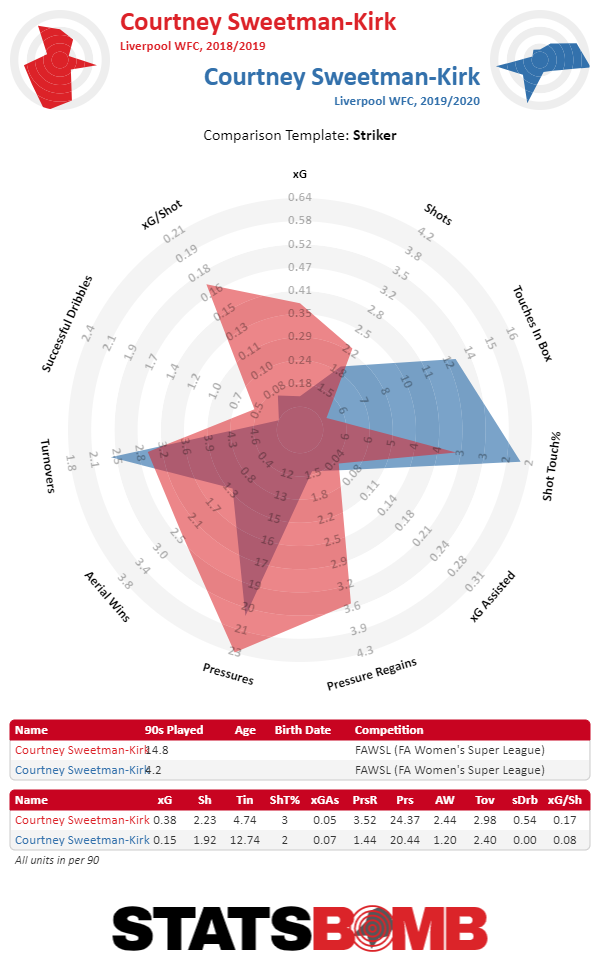 Sweetman-Kirk entered the WSL three seasons ago as a Blue. Before Everton signed her, she had consistently been a top goalscorer in the second tier of the WSL and then went on to become a top goalscorer for the Toffees and earned WSL Player of the Month in November 2017. She then did the unthinkable and signed with Liverpool in 2018, where she went on to score 10 goals. Finishing was her claim to fame something she spoke about focusing on in training: “I work a lot on my finishing and I find that’s the thing that helps the most. You can’t always replicate the same pressure in training as in a match but the more you do it, the more I find it becomes a bit of an automatic thing. I watch analysis on opposition keepers too to see what their habits are, if they normally stay on their line or rush out for example.” She chose her scoring opportunities wisely as is evidenced by this shot map from last season:
Sweetman-Kirk entered the WSL three seasons ago as a Blue. Before Everton signed her, she had consistently been a top goalscorer in the second tier of the WSL and then went on to become a top goalscorer for the Toffees and earned WSL Player of the Month in November 2017. She then did the unthinkable and signed with Liverpool in 2018, where she went on to score 10 goals. Finishing was her claim to fame something she spoke about focusing on in training: “I work a lot on my finishing and I find that’s the thing that helps the most. You can’t always replicate the same pressure in training as in a match but the more you do it, the more I find it becomes a bit of an automatic thing. I watch analysis on opposition keepers too to see what their habits are, if they normally stay on their line or rush out for example.” She chose her scoring opportunities wisely as is evidenced by this shot map from last season: 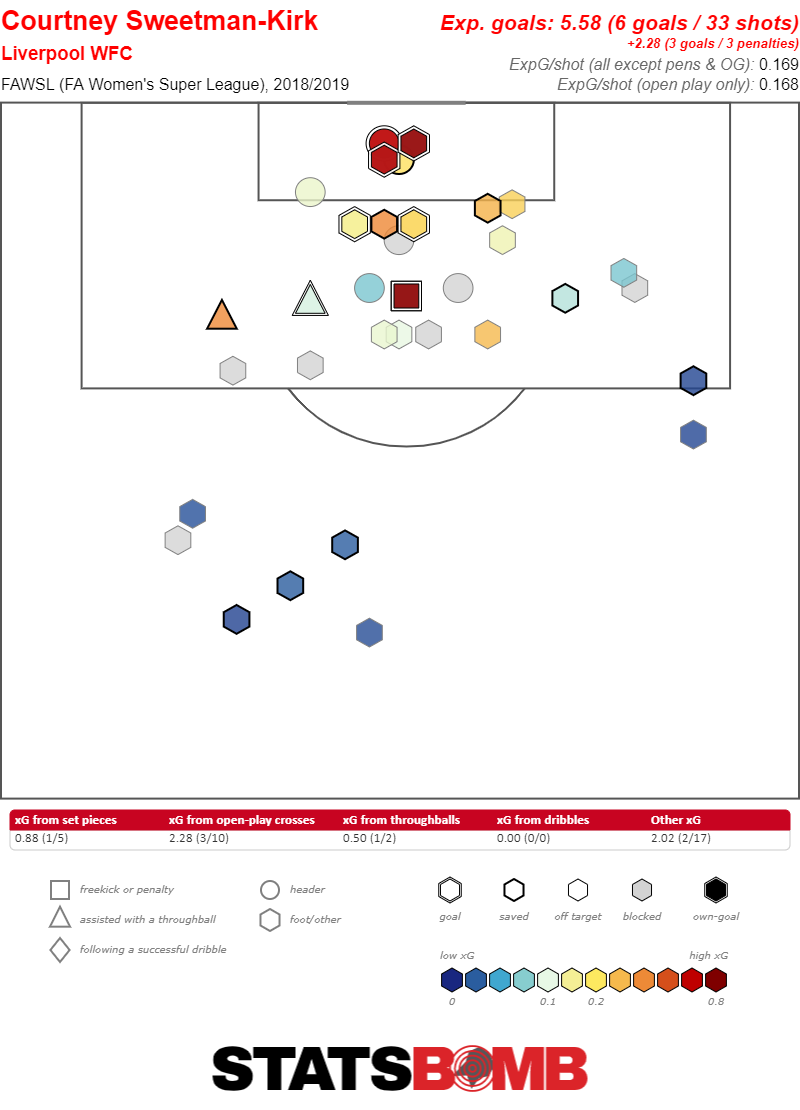 Compare that to this season’s shot map, which suggests that she's either forgotten where the goal is, or is struggling with a lack of service.
Compare that to this season’s shot map, which suggests that she's either forgotten where the goal is, or is struggling with a lack of service. 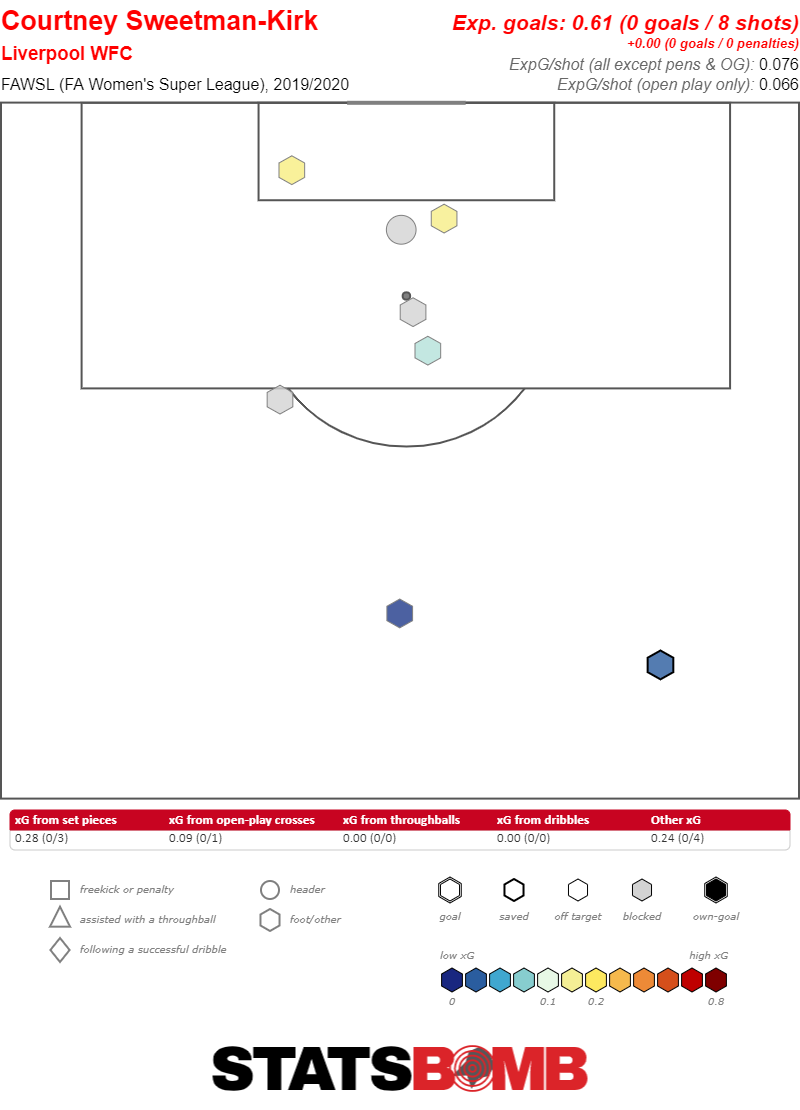 In a rapidly changing league, Liverpool may not have been ambitious enough during the offseason to keep up with clubs like Chelsea who, adding strength to strength, have just announced the signing of one of the best players in the world, Sam Kerr. Everton, on the other hand, have escaped what had seemed like a predetermined fate to come in second to last place every season by exceeding expectations, and are currently in 5th place. So why are Everton so surprisingly good this season? While the Reds’ striker has been coming up empty, the Blues have one of the most in-form attackers in the WSL in Chloe Kelly. After only scoring once in 11 appearances last season before undergoing ankle surgery in February, Kelly has since rehabbed into the Bionic Woman. Playing mainly from the left wing she's scoring worldlies from way downtown and is currently the top goalscorer of the league, with four goals out of five games, beating out even Arsenal wunderkind Vivianne Miedema.
In a rapidly changing league, Liverpool may not have been ambitious enough during the offseason to keep up with clubs like Chelsea who, adding strength to strength, have just announced the signing of one of the best players in the world, Sam Kerr. Everton, on the other hand, have escaped what had seemed like a predetermined fate to come in second to last place every season by exceeding expectations, and are currently in 5th place. So why are Everton so surprisingly good this season? While the Reds’ striker has been coming up empty, the Blues have one of the most in-form attackers in the WSL in Chloe Kelly. After only scoring once in 11 appearances last season before undergoing ankle surgery in February, Kelly has since rehabbed into the Bionic Woman. Playing mainly from the left wing she's scoring worldlies from way downtown and is currently the top goalscorer of the league, with four goals out of five games, beating out even Arsenal wunderkind Vivianne Miedema. 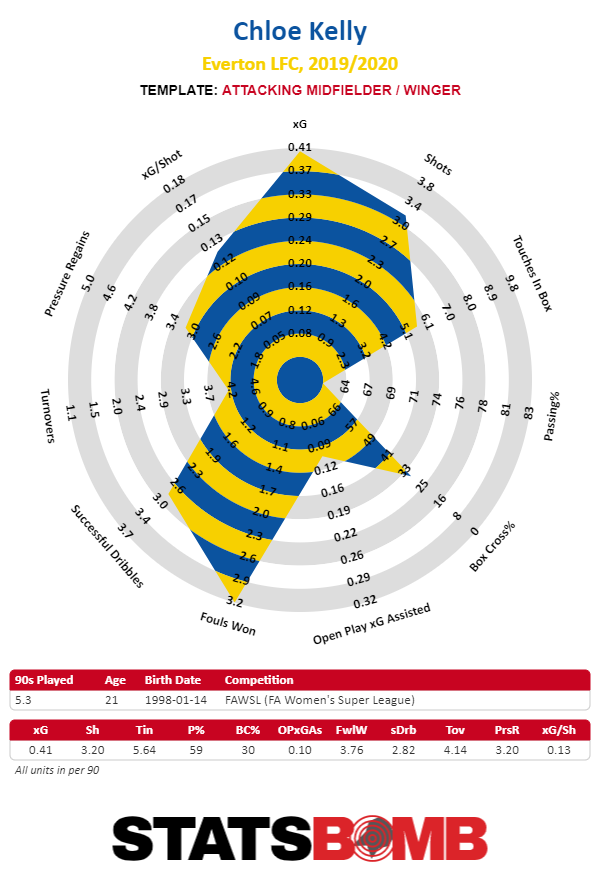 Unfortunately for Everton, however, Kelly will miss the match due to a red card suspension, nullifying one of their most surprisingly successful weapons of the season. Everton also had a much busier offseason than Liverpool, with manager Willie Kirk bringing in six new players, one of whom was a new starting goalkeeper, Finland international Tinja-Riikka Korpela, who has kept three clean sheets and is currently tied with Mary Earps for the second-best goalkeeping record in the WSL.
Unfortunately for Everton, however, Kelly will miss the match due to a red card suspension, nullifying one of their most surprisingly successful weapons of the season. Everton also had a much busier offseason than Liverpool, with manager Willie Kirk bringing in six new players, one of whom was a new starting goalkeeper, Finland international Tinja-Riikka Korpela, who has kept three clean sheets and is currently tied with Mary Earps for the second-best goalkeeping record in the WSL. 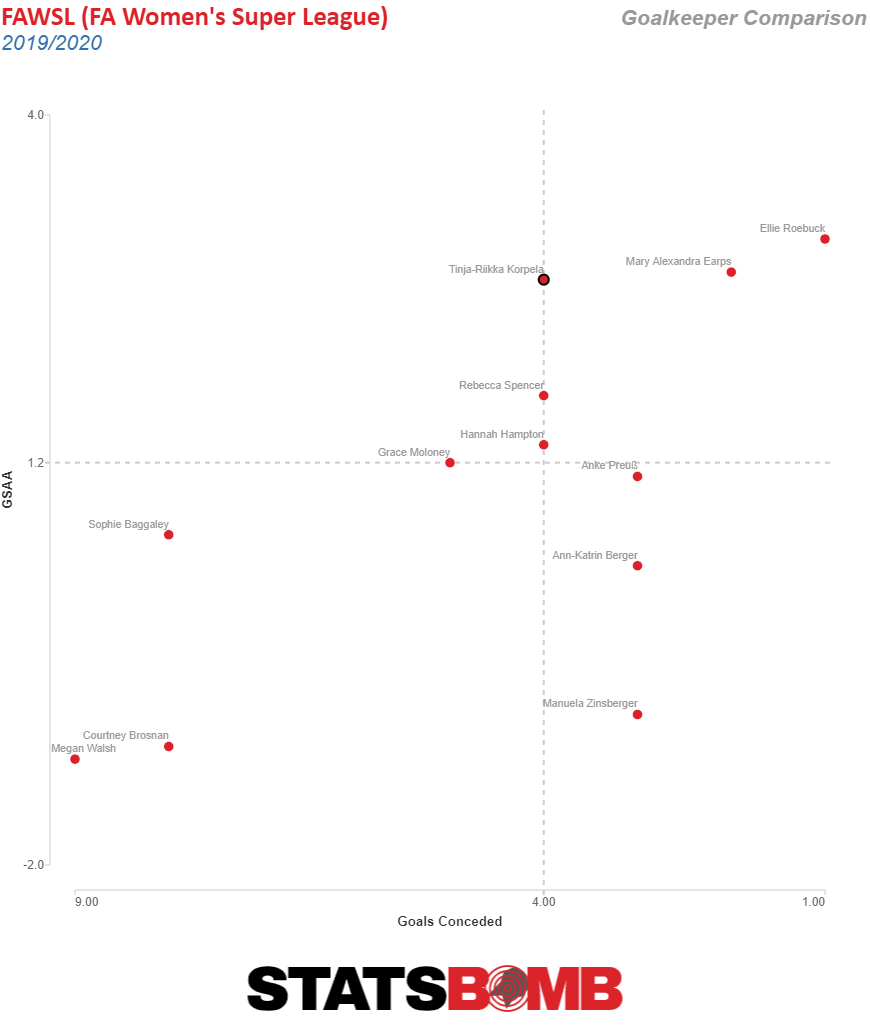 Two other new additions, Lucy Graham and Maeva Clemeron, join Kelly as the top three in combined tackles and interceptions on the team, the backbone of a revamped Everton defense.
Two other new additions, Lucy Graham and Maeva Clemeron, join Kelly as the top three in combined tackles and interceptions on the team, the backbone of a revamped Everton defense. 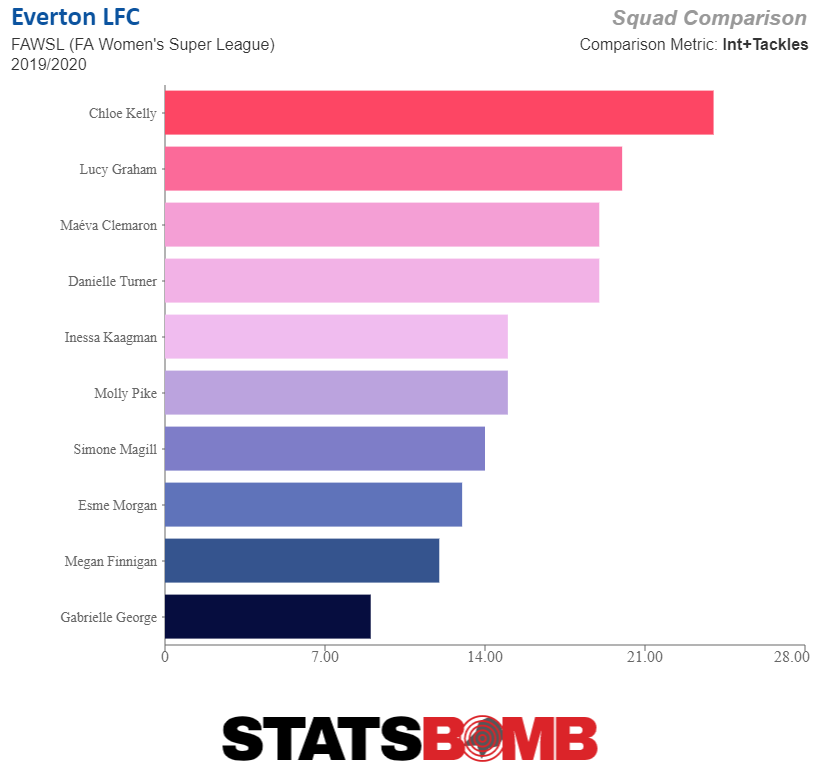 A strong home fan turnout at Anfield, a 54,000 capacity seat stadium, could help bolster the Reds to beat the odds and win on Sunday. Both teams have suffered low attendance in the past, but Everton’s tendency to have the lowest in the WSL continues even after the World Cup bump, with an average home game attendance of just 383, up from last season’s paltry 192. Liverpool is faring better with an average of 1,180 so far this season, which will be shattered on Sunday. But regardless of turnout, the match could provide an extremely rare occurrence: an Everton win over Liverpool at Anfield.
A strong home fan turnout at Anfield, a 54,000 capacity seat stadium, could help bolster the Reds to beat the odds and win on Sunday. Both teams have suffered low attendance in the past, but Everton’s tendency to have the lowest in the WSL continues even after the World Cup bump, with an average home game attendance of just 383, up from last season’s paltry 192. Liverpool is faring better with an average of 1,180 so far this season, which will be shattered on Sunday. But regardless of turnout, the match could provide an extremely rare occurrence: an Everton win over Liverpool at Anfield.
After the dismal showing by The Lionesses in front of a record crowd of 77,768 at Wembley, we can all breathe a big sigh of relief and get back to some Women’s Super League this weekend. There are several tasty looking fixtures too. It’s derby day on Merseyside and also in North London, but not to be outdone, league leaders Chelsea host new kids on the block Manchester United at The Cherry Red Records Stadium (the artistic ground formerly known as Kingsmeadow). According to expected goals, Emma Hayes’ Chelsea thoroughly deserve their top spot. Their non-penalty xG per game stands at 2.08, easily the best in the league, while the against figure is 0.65, narrowly second-best behind Arsenal’s. A goal and a half per game better off than opposition is impressive even if the opening fixtures have been fairly kind. Hayes has settled on a fairly robust 4-4-2-ish set up in recent weeks with either Fran Kirby or Ramona Bachmann playing slightly off the ever-ready Bethany England up front. With Chelsea putting teams on the back foot with their possession through a mix of both buildup from the back and direct balls into the channels, a lot of good attacking work comes from quick turnovers. Erin Cuthbert and Ji So-yun stand out in winning the ball back and Chelsea lead the way in high press shots. Here those two are combining for one of those:  Ji is basically Chelsea’s go-to player. Dominant in so many metrics, the South Korean’s closest player match-ups in the Statsbomb database include Barcelona version Andres Iniesta, Liverpool version Philippe Coutinho and Manchester City’s David Silva. Enough said:
Ji is basically Chelsea’s go-to player. Dominant in so many metrics, the South Korean’s closest player match-ups in the Statsbomb database include Barcelona version Andres Iniesta, Liverpool version Philippe Coutinho and Manchester City’s David Silva. Enough said: 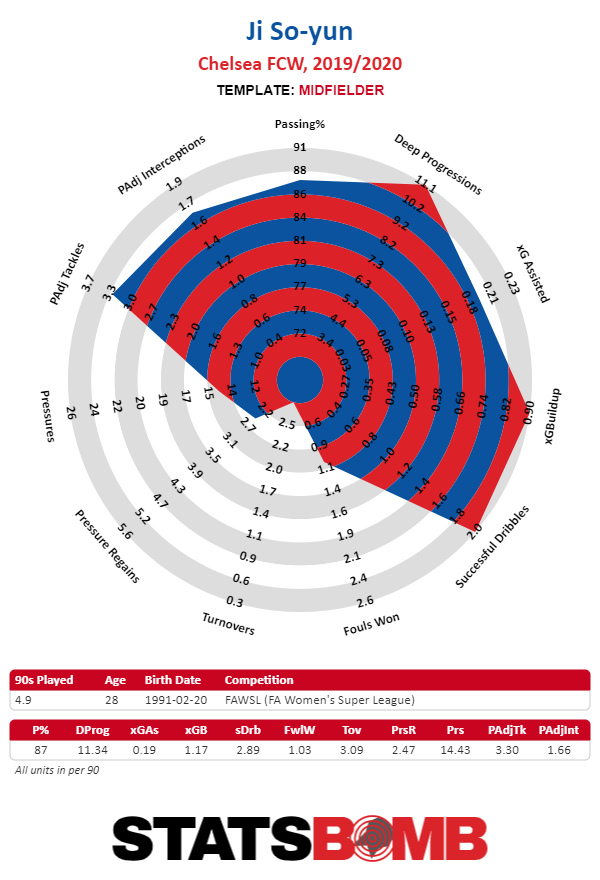 Even against champions Arsenal, playing in a two v three in the middle of the park, she’s bossing it:
Even against champions Arsenal, playing in a two v three in the middle of the park, she’s bossing it: 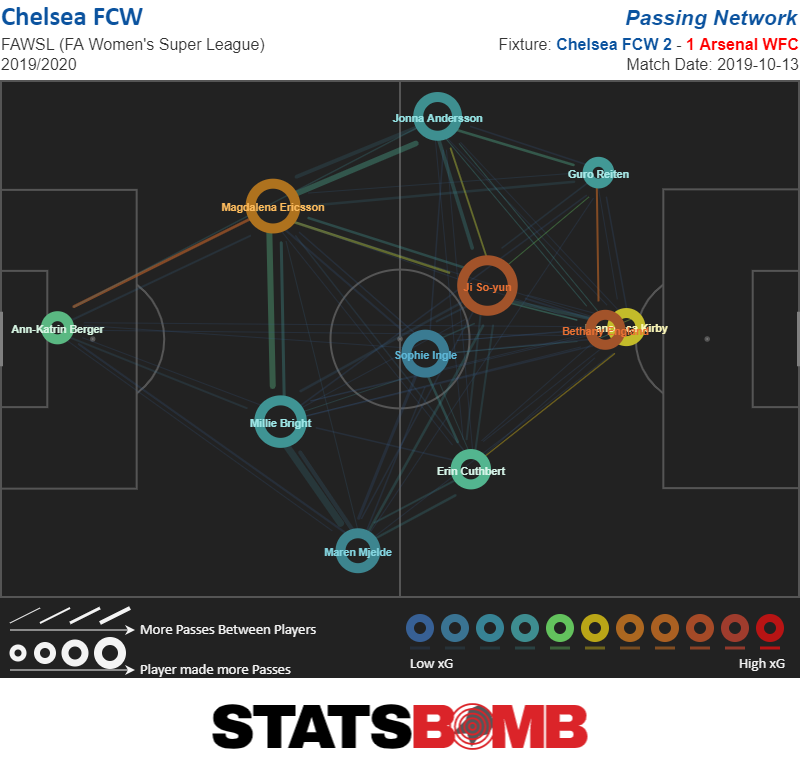 What of Casey Stoney’s Red Devils, then? United currently sit fourth in the non-penalty xG difference table at 0.51 per game and sit fourth in the actual table too, leaders of the ‘best of the rest' group. That’s pretty impressive for a newly promoted side, no? With impossibly horrific opening fixtures against Manchester City and Arsenal, followed by Liverpool, Reading and Spurs, Stoney has tinkered about with the side, setting them up differently almost every time. Consequently, the squad has been well rotated already. Whoever is picked, though, it’s fair to say United like to defend deep and bring the opposition on:
What of Casey Stoney’s Red Devils, then? United currently sit fourth in the non-penalty xG difference table at 0.51 per game and sit fourth in the actual table too, leaders of the ‘best of the rest' group. That’s pretty impressive for a newly promoted side, no? With impossibly horrific opening fixtures against Manchester City and Arsenal, followed by Liverpool, Reading and Spurs, Stoney has tinkered about with the side, setting them up differently almost every time. Consequently, the squad has been well rotated already. Whoever is picked, though, it’s fair to say United like to defend deep and bring the opposition on: 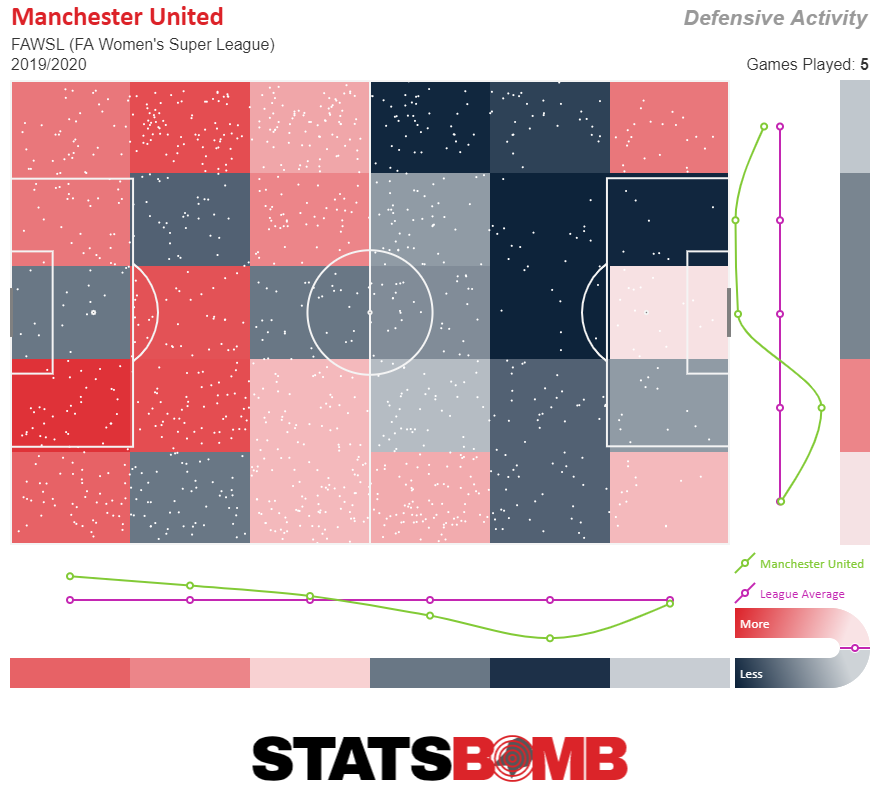 The team wallow at the bottom of the passes per defensive action (PPDA) table, allowing over 12 passes before making a defensive action. Even perennial bus parkers Bristol City get stuck in quicker than that. On average, United make their defensive moves well over 10 yards further back than upcoming opponents Chelsea. In goal, England No.1 Mary Earps is fairly well protected, as United are pretty good at preventing high-value shots, second only to Arsenal. She's having a good season so far, conceding only 2 goals when post-shot xG would expect nearly 5. While for England, Phil Neville has her playing out from the back, at United, she goes longer than any other keeper in the league. This showed while watching the England match live last Saturday. Earps didn’t appear switched on enough to doing things quickly and looked slow and deliberate with the ball at her feet. To be fair, however, Steph Houghton and Leah Williamson were also in a daze too. Left-sided midfielder, Katie Zelem is generally the hub of the team. That considered, you can see from her radar that perhaps United aren’t a run of the mill side:
The team wallow at the bottom of the passes per defensive action (PPDA) table, allowing over 12 passes before making a defensive action. Even perennial bus parkers Bristol City get stuck in quicker than that. On average, United make their defensive moves well over 10 yards further back than upcoming opponents Chelsea. In goal, England No.1 Mary Earps is fairly well protected, as United are pretty good at preventing high-value shots, second only to Arsenal. She's having a good season so far, conceding only 2 goals when post-shot xG would expect nearly 5. While for England, Phil Neville has her playing out from the back, at United, she goes longer than any other keeper in the league. This showed while watching the England match live last Saturday. Earps didn’t appear switched on enough to doing things quickly and looked slow and deliberate with the ball at her feet. To be fair, however, Steph Houghton and Leah Williamson were also in a daze too. Left-sided midfielder, Katie Zelem is generally the hub of the team. That considered, you can see from her radar that perhaps United aren’t a run of the mill side: 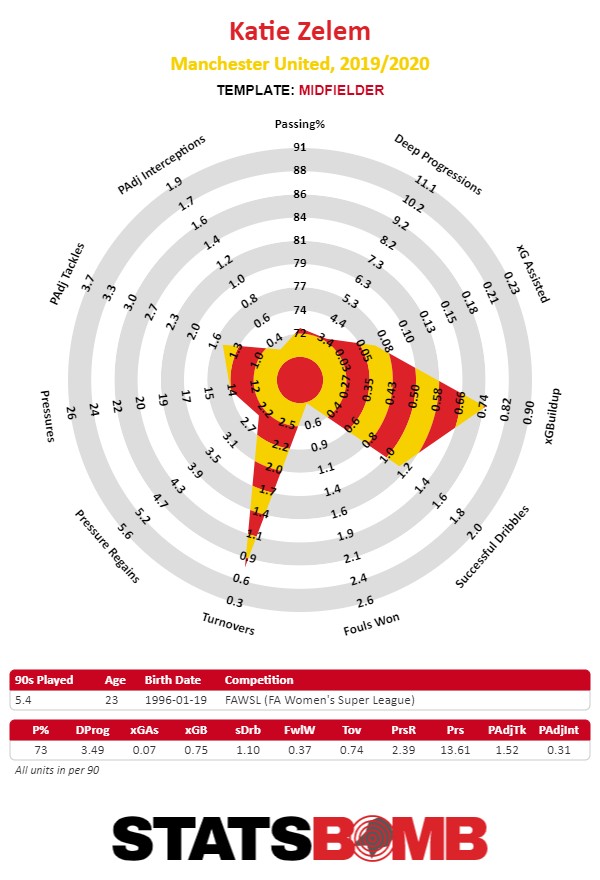 The pass sonar for Zelem also reveals how United might want to play Chelsea. Zelem’s pass completion is perhaps represented by how often the vertical ball is chosen over merely recycling possession.
The pass sonar for Zelem also reveals how United might want to play Chelsea. Zelem’s pass completion is perhaps represented by how often the vertical ball is chosen over merely recycling possession. 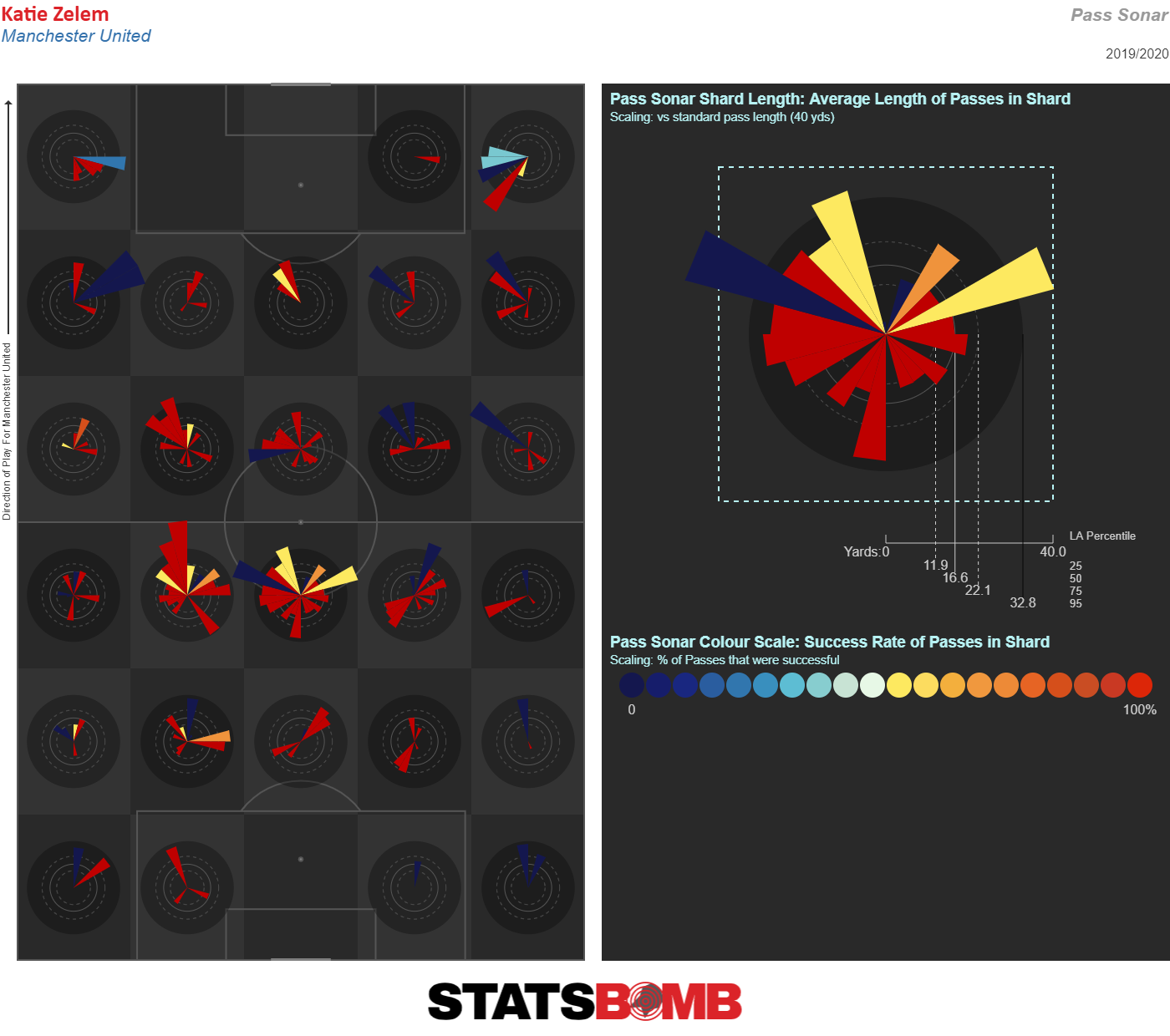 Looking back at the defensive viz for United we can see defensive pressure being applied into the far corners. In the opener against City, United repeatedly sent the ball down the sides and chased the superior footballing team backwards. United hunted in packs of 3s and 4s, bombing on to put City under pressure. This accomplished two things: it made them a threat on the counter, and forced City as far away from goal as possible, having to build moves from their own box while having opposition players cutting off passing lanes. Ultimately it didn’t work, but United did create good chances and were really unlucky not to score. It is almost written in stone that Chelsea will dominate the ball in this fixture, and it will be a fascinating cat and mouse game if United can prevent Chelsea from scoring early on. That's a big if, however. United are a physical team but so are Chelsea. United look like they can run all day at times, but if there’s one side that will stand up and fight it’s Chelsea. I wouldn’t be surprised if Chelsea make United pay at corners. I’m not convinced by Earps’ ability to relieve the pressure there. Chelsea have good routines and good aerial ability while United have the worst numbers in the league when it comes to conceding chances at corners. United do have a wildcard in youngster Lauren James. I first saw James properly last season running rings around older players and generally making things look too easy. Therein also lies James’ problem. All too often it seems so easy for her that she can’t be bothered. It would be brilliant if she turned up and shone in a big game like this. As it is, I’m not even sure she’ll make the starting line-up. Which is a shame because she can do this:
Looking back at the defensive viz for United we can see defensive pressure being applied into the far corners. In the opener against City, United repeatedly sent the ball down the sides and chased the superior footballing team backwards. United hunted in packs of 3s and 4s, bombing on to put City under pressure. This accomplished two things: it made them a threat on the counter, and forced City as far away from goal as possible, having to build moves from their own box while having opposition players cutting off passing lanes. Ultimately it didn’t work, but United did create good chances and were really unlucky not to score. It is almost written in stone that Chelsea will dominate the ball in this fixture, and it will be a fascinating cat and mouse game if United can prevent Chelsea from scoring early on. That's a big if, however. United are a physical team but so are Chelsea. United look like they can run all day at times, but if there’s one side that will stand up and fight it’s Chelsea. I wouldn’t be surprised if Chelsea make United pay at corners. I’m not convinced by Earps’ ability to relieve the pressure there. Chelsea have good routines and good aerial ability while United have the worst numbers in the league when it comes to conceding chances at corners. United do have a wildcard in youngster Lauren James. I first saw James properly last season running rings around older players and generally making things look too easy. Therein also lies James’ problem. All too often it seems so easy for her that she can’t be bothered. It would be brilliant if she turned up and shone in a big game like this. As it is, I’m not even sure she’ll make the starting line-up. Which is a shame because she can do this: 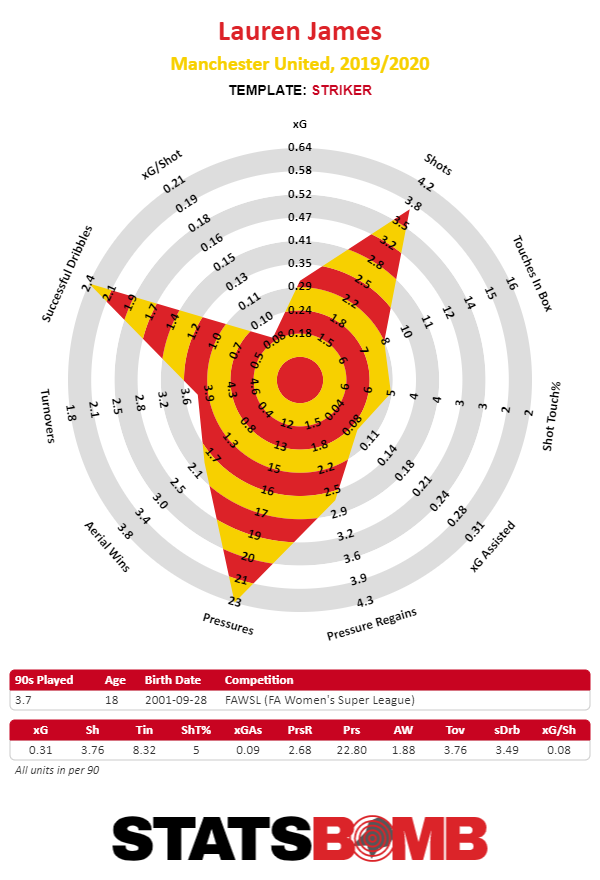
The Women’s Super League is five games in and we have a tasty, tasty title race on our hands.
‘The Big Three’ (as I’ve taken to calling them) of 2017-18 champions Chelsea, 2018-19 champions Arsenal, and 2016* champions Manchester City are separated by just one point at the top of the table.
*Before 2017-18, the WSL was played on a summer rather than winter season schedule
But England’s top tier of women’s football is not a three-team league and there’s plenty going on up and down it. Here are the broad headline trends before we take a proper look at the table.
- The Big Three remain the Big Three for now, but Manchester United may be joining them soon
- There’s a definite midtable group: by eye and by stat, West Ham and Everton are in there, as are Reading and Tottenham, although things get more fluid towards the bottom of this group and the top of the third group…
- …this group is the bottom four in the current league table, who probably all deserve to be there. Bristol City, despite their sixth-place finish in 2018-19, appear to be really struggling looking at the stats.
Here’s the table at the moment (NB: Reading and Birmingham City have had a match postponed):
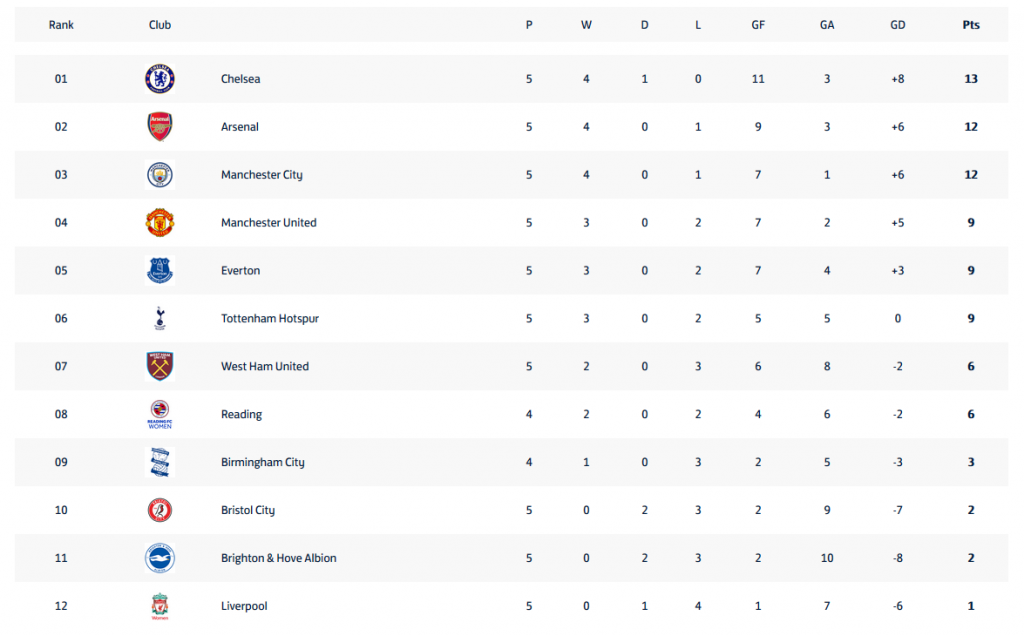
And we’ve also got the teams sorted by StatsBomb’s expected goals per game (a measure of chance quality, specifically with penalties stripped out as spot-kicks are extremely high value but can happen pretty randomly). Fixture schedule or a one-off tonking can skew the numbers a bit, but here we go:
While the Big Three exists in terms of points and overall quality, there are some interesting quirks in how they play. Arsenal women are doing what Arsène Wenger would have been proud of the men doing back in the day: possession, and plenty of it. Joe Montemurro’s team average the most spells of possession per game that contain 10 or more passes (22.0), more than double the third-highest team on the list (Chelsea, with 10.6).
Manchester City are the team sandwiched between them, but though City are pass-happy with the ball, they’re a slightly unexpected mix defensively. They’ll certainly press you if you get the ball in your own defensive third – only 20% of the possessions starting there against City have lasted long enough to string five or more passes together, giving City the second press-iest rate in the league.
However, if you manage to make it out of the press alive, they seem to relent. They allow 8.6 possession sequences with 10+ passes per game, which is the second-highest amount in the league. It’s even more than the lowly Bristol City, whose opponents only manage an average of 7.8. City are, generally, surprisingly easy to pass through for a team challenging for the title, and their latest outing, a crunch match against Arsenal, was stark in terms of the difference between the two sides on the day.
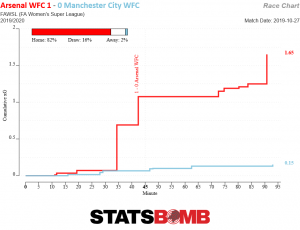
That win was a big three points for Montemurro’s Gunners, as had they lost, they’d have been six points behind City. A defeat to Chelsea in mid-October provoked wonders about the team’s ability to defend last season’s title and ire from Montemurro:
A first for me today- I’ve never seen Joe Montemurro angry before, but he was today. I asked him if the plan was to play on the counter in the second half. ‘No, we just played badly and couldn’t keep the ball.’
— Tim Stillman (@Stillberto) October 13, 2019
The Australian manager has noted in the past how he prefers a small squad and, unlike the previous league campaign, he’s actually having to use it. Arsenal averaged the second-fewest changes to their starting XI from match-to-match in the WSL last season (1.3) but so far in 2019/20 they’ve averaged the most (2.25). The number of changes isn’t necessarily meaningful in and of itself, but that large a change certainly seems indicative of a team who had things going their way last season in a way that they aren’t quite this time around.
That’s worrisome because Arsenal, and City for that matter, will have to be the the top of their game to keep pace with Chelsea this season. The Blues have the strongest numbers of the trio and no Champions League to contend with (although neither, after this week, do City). They're built on a solid defensive foundation and have a great cast of attacking players to contribute to attack: Fran Kirby, Erin Cuthbert, Ji So-yun, striker Bethany England, and new signing Guro Reiten give a great strength in depth.
And last season's campaign, finishing third in the league and 12 points off winners Arsenal, will surely be a source of inspiration for the Blues. Being that far off first in a title defence year must have stung, not helped by a start to the season of three goalless draws but an expected goals balance of 4.67 to 1.49. This season they've had no such stumbles, and it's set the title race up nicely.
In terms of the midtable chasers we can talk about Manchester United another time – they will not be short of column inches this season – but Everton and West Ham look like they’re worth paying attention to. The Hammers are a solidly good side who turn up against the big guns and are led by Matt Beard, twice-winner of the WSL as manager of Liverpool in 2013 and 2014 (back before they were neglected into becoming relegation-battlers…). They have 16 players born outside the UK, the highest number in the league and a figure I’ve taken from a great article by Kieran Theivam on The Athletic about just how a WSL side deals with that (although one might wonder whether player settling services might be something that a club like West Ham could share between men’s and women’s sides). Everton, meanwhile, have a much more homegrown squad, including 21-year-old September Player of the Month Chloe Kelly, who currently leads the league on four goals in five games. Sure, she’s overperforming her expected goals, and that expected goals figure is inflated by a single near-open-goal shot against Reading, but she’s fun to watch.
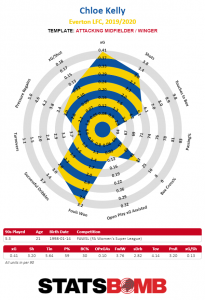
Speaking of fun to watch, Manchester City’s Janine Beckie has hit the ground running after spending the majority of last season out injured. The Canadian is currently averaging 2.53 successful dribbles per game and the highest xG per 90 in the league (0.62). The vast majority of her expected goals comes after receiving through-balls, a major chunk of the rest comes immediately after a dribble, and as much as I would prefer to big up players outside the major clubs, Beckie’s someone you’ll want to tune in for (even if she’s yet to score in the league).
But in terms of pure influence for their team, few could rival Reading’s Fara Williams. The 170-capped England legend set up all three goals in the recent win over Everton and has the sixth-highest expected goals contribution per game in the league (0.64; 0.22 expected goals plus 0.42 expected goals assisted).
The 34-year-old is helping to power a team who look like they’re trying to set-piece their way to victories. So far, they’re first in the league for expected goals per game created from dead-ball situations and only seventh from open-play. Granted, their set-piece defence is the second-worst in the league at this stage, but Williams’ delivery, and all-round quality and experience, is something that most teams would be very envious to have.
One of which would be Liverpool, and given that I mentioned earlier that they were ‘neglected into becoming relegation-battlers’, I should elaborate on their situation (particularly given the success and positive press that the men’s team, and club as a whole as an extension, are receiving at the moment).
Right at the start of last season, manager Neil Redfearn resigned, just three months into the job after previous manager Scott Rogers left. The intervening months had seen many players change one red shirt for another and join the then-newly formed Manchester United, while Redfearn’s sole game in charge was a 5-0 defeat to Arsenal. That the Gunners eventually went on to win the title makes that scoreline look a little less embarrassing in hindsight, but there’s no positive way to spin the rumours that the impromptu departure was down to dissatisfaction at how the women’s team was being run.
Since last season, there has been a smidgen of a recovery. There is, at least, more stability in the coaching set-up and a relatively star player in Melissa Lawley, who’s arrived from Manchester City. Lawley is doing what she can – averaging over three dribbles and nearly six deep progressions (passing or carrying the ball into the final third) per game, as well as the longest average carry distance in the league – but she can only do so much. No-one in the squad is contributing more than 0.15 non-penalty expected goals per 90. For reference, Arsenal centre-back Leah Williamson is averaging 0.12, and Liverpool only have two players beating that.
It’s certainly going to be a tough old season for the Reds, who are not only bottom of the league on one point but are also the only team yet to play one of the Big Three. Their next trio of league matches (starting on 17 November after an international break) are a Merseyside Derby at Anfield (that, on form, they look likely to lose); a trip to Arsenal; and a trip to Manchester City. They then have a home game against West Ham before hosting Chelsea, so it isn’t beyond the realms of possibility for them to go into Christmas still without a win.
But let’s end this on a happier note. Now-Manchester United winger Leah Galton took a break from football in 2018 after having fallen out of love with football. She’s now back, is ripping up the league on United’s left, and made the news this week for having turned down a call-up to the England squad, though not for acrimonious reasons.
Here’s United manager Casey Stoney: "Playing for your national team is something that Leah and other players dream of, however I am strong on a player’s needs coming first and seeing them as human beings. Leah is just starting to fall back in love with the game again and I fully support her in not being ready for that next step yet.”
Manchester United took far, far too long to re-establish their women’s team after disbanding it in 2005, but it’s nice to see them taking good decisions since they’ve joined the party.
It’s one of the pains of tournament football that Sam Kerr won’t be playing another match at the World Cup.
The Australian is one of the, if not the, best strikers in the world and yet must go home in the round of 16. Until this year, the more casual fans of the women's game could be forgiven for being unaware of Kerr’s quality. She hadn’t scored a single World Cup goal before this edition, where she scored five, and in the 2016 Olympics only scored one in three appearances.
But this is the NWSL all-time leading goalscorer we’re talking about. The woman who, since 2017 (as far back as records on fbref.com go for her) has scored 52 goals in 58 league appearances. She only took up football (association, rather than her first love Aussie rules) at 12 and had to contend with an ACL injury at 18, but she’s still managed to become a truly great forward.
If you still need convincing, but don’t want to have to search for old games, the effects of her elite movement and sense for goal are clear in the stats.
Few players this World Cup have got clear shots on goal, free of defenders, like Kerr. With StatsBomb’s freezeframes, which take a snapshot of where the players are at the point a shot is taken, we can see how many players a striker has in the ‘cone’ between them and the goal.
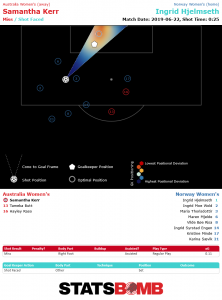
Kerr managed eight of her ten footed shots with no outfield defenders in the cone between her and goal, an extraordinary 80% rate. Apart from Norway's Caroline Graham Hansen, who managed to make ten of her 12 shots completely unobstructed by defenders, no-one really comes close. Only four forwards in the entire tournament have managed more than five of these clear shots.
It’s this skill in slipping in the gaps between defenders and making a run at the right time that led to her having one of the best figures for the average quality of her shots. Taking out her penalty rebound which will naturally skew the figures, these shots of Kerr’s have had an average expected goals value of 0.19; none of the other six players to have taken ten or more of this type of shot this tournament can beat that.
(A less meaningful and, possibly, slightly more fortuitous symptom of this elite striker's movement is also the fact that only a single one of Kerr's 18 shots were blocked throughout the tournament. Kerr finds space).
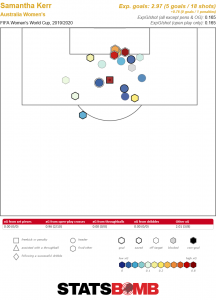
But, like so many stars on teams where the gap between star and next-best shows, the striker had to try and turn creator against Norway, with her team chasing the game after conceding in the 31st minute.
She set up three shots in the game, after having only set up two in the tournament prior to that (one each against Brazil and Jamaica), and completed more passes inside the box than she had throughout the tournament up to that point as well.
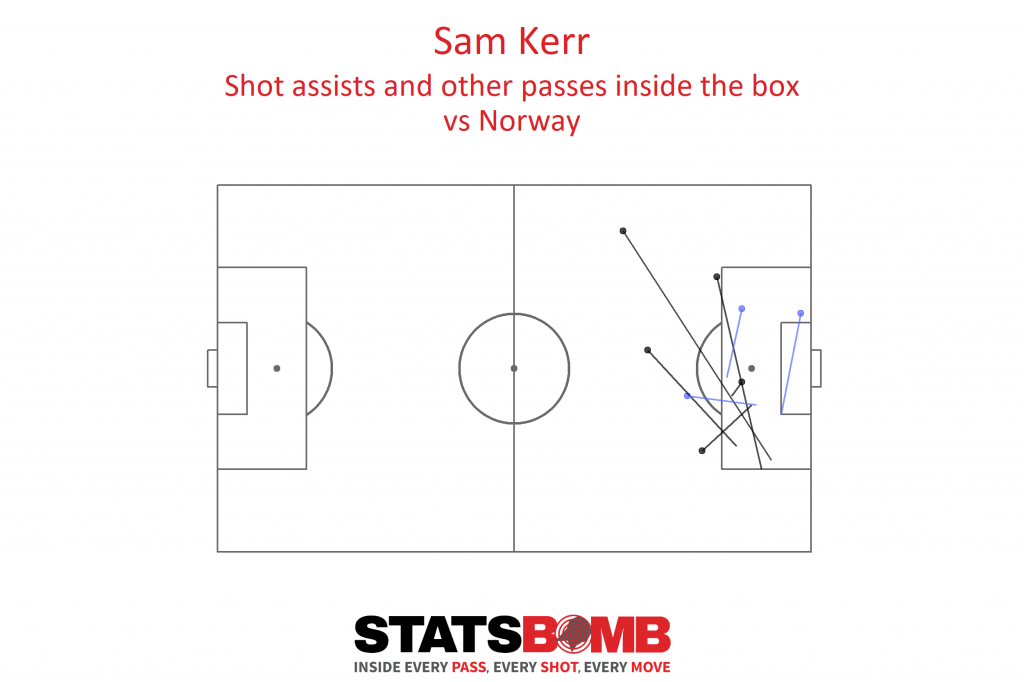
No teammate of Kerr's set up more shots during those 120 minutes, and none even reached half of her eight completed open-play passes inside the box. On the defensive side as well, only central midfielders Chloe Logarzo and Tameka Butt pressured the opposition more often.
Unfortunately - for her, for the nation, for her fans - it wasn't enough. Penalties seem to haunt Kerr. Her attempt saved against Italy, then her skied effort in the shoot-out and her fellow teammates struggles. Even on club level, fbref.com has her at only two from four attempts.
But those spot-kicks have been her only negative moments. The World Cup is a time to bring together the best players that the sport has to offer, for compatriots to hitch their hopes to their wagon, and for neutrals to bask in the collected magic.
Having Kerr in France, even though she'll go no further, has delivered on that. The same goes for Marta, one of the greatest players of all time and eliminated with Brazil while this piece was being written. At 33, she might not be seen at a World Cup again.
And, as well as their on-field quality, the pair have delivered two of the lines of the tournament. Kerr, telling critics of the Australian team to "go suck on that one" after their comeback win against Marta's Brazil in the group stage; Marta herself, telling her nation to value women's football more, for girls to take up football, and to "cry now so you can smile at the end." Thank you Sam Kerr, and to Marta. The 2019 World Cup'll miss you.
If you're a lover of football, England is the place to be. The men's side of the club game filled the semi-finals of both major European competitions, and the FA Women's Super League will be one of the best-represented leagues at this summer's World Cup. We covered the English and Scottish players that the WSL is sending to France earlier in the week, but that still leaves a good number still to cover. Another seven nations are represented by English top-tier clubs, although, with the transfer window ongoing, that could well increase before or during the tournament. A sizeable share of these WSL international stars are from 2017 European champions, the Netherlands. As a demonstration of how frantic the pre-tournament transfer window has been, Arsenal's Dutch offering went from four to two to three in the space of a matter of days shortly after the end of the season. However, it's 2018/19 WSL top scorer and PFA Player of the Year Vivianne Miedema and midfielder Daniëlle van de Donk who are the big names. Miedema's radar chart tells the story of a fantastic season, where she breaks the scale on three different stats. The 22-year-old averaged 5.36 shots and 0.76 expected goals per game, an astonishing level of attacking firepower. As if that wasn't enough, Van de Donk scored a full eight goals from the six-yard box alone.
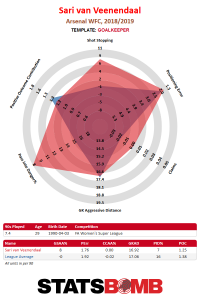 She was displaced in the pecking order by France's Pauline Peyraud-Magnin who, while seemingly a more questionable shot-stopper, led the league in claiming more crosses than expected. For Arsenal, perhaps this decision of Peyraud-Magnin over Van Veenandaal makes sense, if the Gunners are facing teams more likely to be limited to throwing in crosses than taking meaningful shots. Internationally, though, Peyraud-Magnin is unlikely to see much game-time behind France's first choice, Lyon's Sarah Bouhaddi. Back with Holland, and Bristol City get some World Cup representation with Danique Kerkdijk in France as a back-up central defender to Bloodworth, if the warm-up games are to be believed. Everton midfielder Inessa Kaagman is also in the squad. Clearly wanting to restore balance to the Dutch north London Force, Jill Roord has been announced as an incoming Arsenal transfer, and is clearly pretty happy to be joining some of her compatriots. https://twitter.com/ArsenalWFC/status/1128314612418580486 International teammates joining up at the same club side is a story at Chelsea too, who have key players for Norway (who Katja Kragelund has previewed here) as well as Sweden. In Hedvig Lindahl, the Swedes have one of the best goalkeepers of the WSL, although she might want to keep an eye on her bottom-right corner.
She was displaced in the pecking order by France's Pauline Peyraud-Magnin who, while seemingly a more questionable shot-stopper, led the league in claiming more crosses than expected. For Arsenal, perhaps this decision of Peyraud-Magnin over Van Veenandaal makes sense, if the Gunners are facing teams more likely to be limited to throwing in crosses than taking meaningful shots. Internationally, though, Peyraud-Magnin is unlikely to see much game-time behind France's first choice, Lyon's Sarah Bouhaddi. Back with Holland, and Bristol City get some World Cup representation with Danique Kerkdijk in France as a back-up central defender to Bloodworth, if the warm-up games are to be believed. Everton midfielder Inessa Kaagman is also in the squad. Clearly wanting to restore balance to the Dutch north London Force, Jill Roord has been announced as an incoming Arsenal transfer, and is clearly pretty happy to be joining some of her compatriots. https://twitter.com/ArsenalWFC/status/1128314612418580486 International teammates joining up at the same club side is a story at Chelsea too, who have key players for Norway (who Katja Kragelund has previewed here) as well as Sweden. In Hedvig Lindahl, the Swedes have one of the best goalkeepers of the WSL, although she might want to keep an eye on her bottom-right corner. 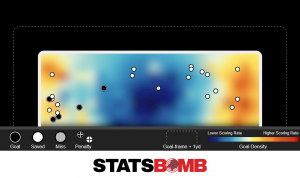 Chelsea's Jonna Andersson and Magdalena Ericsson will be joining Lindahl in France. At club level, they're the Blues' regular left-back and left-sided centre-back respectively, but in recent national team games they've occasionally been used as like-for-like replacements. Ericsson's defensive activity map shows a concentration of action towards the left sideline, which is interesting. It suggests that the centre-back isn't afraid to move around and up the field to pressure opponents and cut out attacks.
Chelsea's Jonna Andersson and Magdalena Ericsson will be joining Lindahl in France. At club level, they're the Blues' regular left-back and left-sided centre-back respectively, but in recent national team games they've occasionally been used as like-for-like replacements. Ericsson's defensive activity map shows a concentration of action towards the left sideline, which is interesting. It suggests that the centre-back isn't afraid to move around and up the field to pressure opponents and cut out attacks. 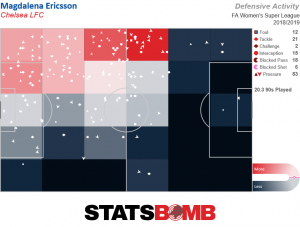 As a comparison, here's England's Steph Houghton. The Lionesses and Manchester City captain still makes those defensive actions towards the sideline, but has a far higher concentration closer to her own goal as well.
As a comparison, here's England's Steph Houghton. The Lionesses and Manchester City captain still makes those defensive actions towards the sideline, but has a far higher concentration closer to her own goal as well. 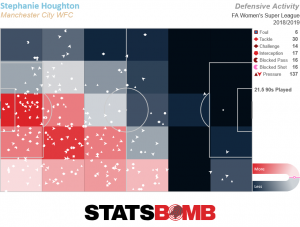 The WSL also sees representation on Canada and New Zealand's squads, and these players could well face each other, as both nations were drawn in Group E. On the Canadian side, Janine Beckie struggled to get regular time for Manchester City, with 283 minutes spread over ten appearances, only two of which were starts. Adriana Leon was a more consistent feature for West Ham since joining in January, though. She scored one league goal as well as a brace in the FA Cup, helping the Hammers get to the final (where they lost out to Beckie's City). Speaking of West Ham, who have one of the more international squads in the league, New Zealand's Ria Percival was their regular right-back this season, putting up some impressively solid defensive numbers. Based on the warm-up games in the run-in to the tournament, she'll likely be lining up as a defensive-minded midfielder.
The WSL also sees representation on Canada and New Zealand's squads, and these players could well face each other, as both nations were drawn in Group E. On the Canadian side, Janine Beckie struggled to get regular time for Manchester City, with 283 minutes spread over ten appearances, only two of which were starts. Adriana Leon was a more consistent feature for West Ham since joining in January, though. She scored one league goal as well as a brace in the FA Cup, helping the Hammers get to the final (where they lost out to Beckie's City). Speaking of West Ham, who have one of the more international squads in the league, New Zealand's Ria Percival was their regular right-back this season, putting up some impressively solid defensive numbers. Based on the warm-up games in the run-in to the tournament, she'll likely be lining up as a defensive-minded midfielder. 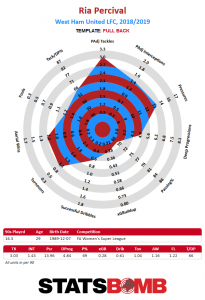 However, national team captain Ali Riley struggled to get time on the pitch for Chelsea in 2018/19 and Everton's Olivia Chance was out for the year with injury. But how much will this lack of game-time end up mattering? All three players featured in New Zealand's recent 1-0 win over England and 1-0 defeat to Wales (who didn't even qualify for the World Cup). National football is unpredictable. But let's finish on a note of consistency. Chelsea's defensive stars have already been touched on, but one of their key attackers, Ji So-Yun, will be a big part of the Korea Republic team. For Chelsea, only Karen Carney created more expected goals in 2018/19, and Ji also popped up with six league strikes of her own.
However, national team captain Ali Riley struggled to get time on the pitch for Chelsea in 2018/19 and Everton's Olivia Chance was out for the year with injury. But how much will this lack of game-time end up mattering? All three players featured in New Zealand's recent 1-0 win over England and 1-0 defeat to Wales (who didn't even qualify for the World Cup). National football is unpredictable. But let's finish on a note of consistency. Chelsea's defensive stars have already been touched on, but one of their key attackers, Ji So-Yun, will be a big part of the Korea Republic team. For Chelsea, only Karen Carney created more expected goals in 2018/19, and Ji also popped up with six league strikes of her own. 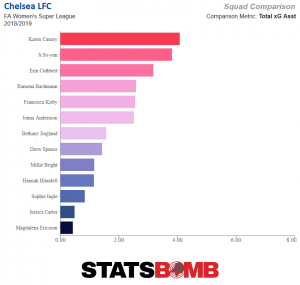 Ji will be joined in France by captain Cho So-Hyun, who joined West Ham in January. Cho scored the winning penalty in the FA Cup semi-final against Reading and generally appears to have performed fairly well, a little more creative than the league average.
Ji will be joined in France by captain Cho So-Hyun, who joined West Ham in January. Cho scored the winning penalty in the FA Cup semi-final against Reading and generally appears to have performed fairly well, a little more creative than the league average. 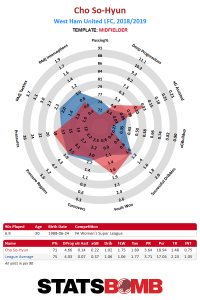 The transfer window will undoubtedly bring even more international stars to the WSL for the 2019/20 season, but the names mentioned here should give some English-based fans something to look out for in the rest of the World Cup.
The transfer window will undoubtedly bring even more international stars to the WSL for the 2019/20 season, but the names mentioned here should give some English-based fans something to look out for in the rest of the World Cup.
It's been nearly a year since StatsBomb announced free data for women’s football. During this time analysts, bloggers and fans have been brushing off their coding skills and navigating github to produce analysis, data visualisations and gifs all entirely focussed on women’s football. This has been really enjoyable to watch for two reasons:
- By removing barriers to accessing quality data we are enabling a promising data analytics talent pool to develop.
- We are making inroads to address the gender imbalance in the football industry.
However, the purpose of data analytics is not only to view the game through a different lens from a spectator capacity, but for information and insight to filter through to teams. By engaging coaches in a data-led process, information can ultimately filter down to the players themselves and help drive improvements on the pitch.
At StatsBomb, we spend a lot of time talking to teams at all levels, from the elite, through lower tiers, academies and even local grassroots teams. In 2019, teams are actively looking to incorporate data - yet about 95% of our inbound traffic is from the men’s game. We have forged relationships with women’s teams, but we want to do more to address the key barriers of incorporating quality data & analytics - cost and expertise.
So, for the 2019/20 season, all FAWSL teams can have completely free access to our industry leading analytics platform, StatsBomb IQ. The platform is designed to be intuitive, easy to navigate and enables real practical insight. Whether comparing overall team performance on key metrics, evaluating players or reviewing matches, StatsBomb IQ enables a complete, one-stop solution for a whole organisation.
StatsBomb IQ is built upon our already freely available, unique event data, and has over 200 insight metrics providing the information teams need. From straightforward metrics through to those built via deep learning algorithms, StatsBomb IQ provides guidance and understanding to all aspects of football, from passing to ball progression, shot quality to set pieces and much, much more.
In addition to providing free access to our analytics platform, we are also giving FAWSL teams the opportunity for free access to our Introduction to Football Analytics course in London on 10th June where we will be providing training to the fundamentals of using data in football analysis.
We are hoping that by making our platform available throughout the 2019/20 season and giving free training from our highly experienced analysts, all FAWSL teams can enhance their pre and post match analysis workflow. There is no reason why women’s football should miss out on the data revolution that is happening in the men’s game, and StatsBomb are delighted to be in a position to set the stage for this.
For more information, please contact sales@statsbomb.com
The fight for the Women’s Super League title looks like it will decided on the last game of the season when Manchester City travel to Arsenal in May. Manchester City have clawed their way to top spot (having played two games more than the Gunners!) which seemed unlikely as Arsenal had demolished every opponent in sight up until early December. The two sides also come face to face at the end of the month in the League Cup final at Bramall Lane which should be a spicy encounter.  One of the main reasons why City might pip Arsenal to top spot is the form of Nikita Parris. While most media attention has been focused on the goal scoring prowess of Arsenal’s Vivianne Miedema (rightly so as she has smashed many records this season), one should not neglect the contribution that Nikita Parris has made to last season’s runners up. Parris is Manchester City’s top scorer in the league with 14 goals (11 from open play and 3 from the penalty spot) with her xG numbers from open play being quite similar. Only Miedema at Arsenal has scored more goals than her in the league with 16. When looking at her shot map, it’s clear that she shoots consistently in high value areas. She takes high quality shots, with a lot of attempts inside of the 6-yard box (with both head and feet). She's only taken two shots from outside of the penalty area.
One of the main reasons why City might pip Arsenal to top spot is the form of Nikita Parris. While most media attention has been focused on the goal scoring prowess of Arsenal’s Vivianne Miedema (rightly so as she has smashed many records this season), one should not neglect the contribution that Nikita Parris has made to last season’s runners up. Parris is Manchester City’s top scorer in the league with 14 goals (11 from open play and 3 from the penalty spot) with her xG numbers from open play being quite similar. Only Miedema at Arsenal has scored more goals than her in the league with 16. When looking at her shot map, it’s clear that she shoots consistently in high value areas. She takes high quality shots, with a lot of attempts inside of the 6-yard box (with both head and feet). She's only taken two shots from outside of the penalty area. 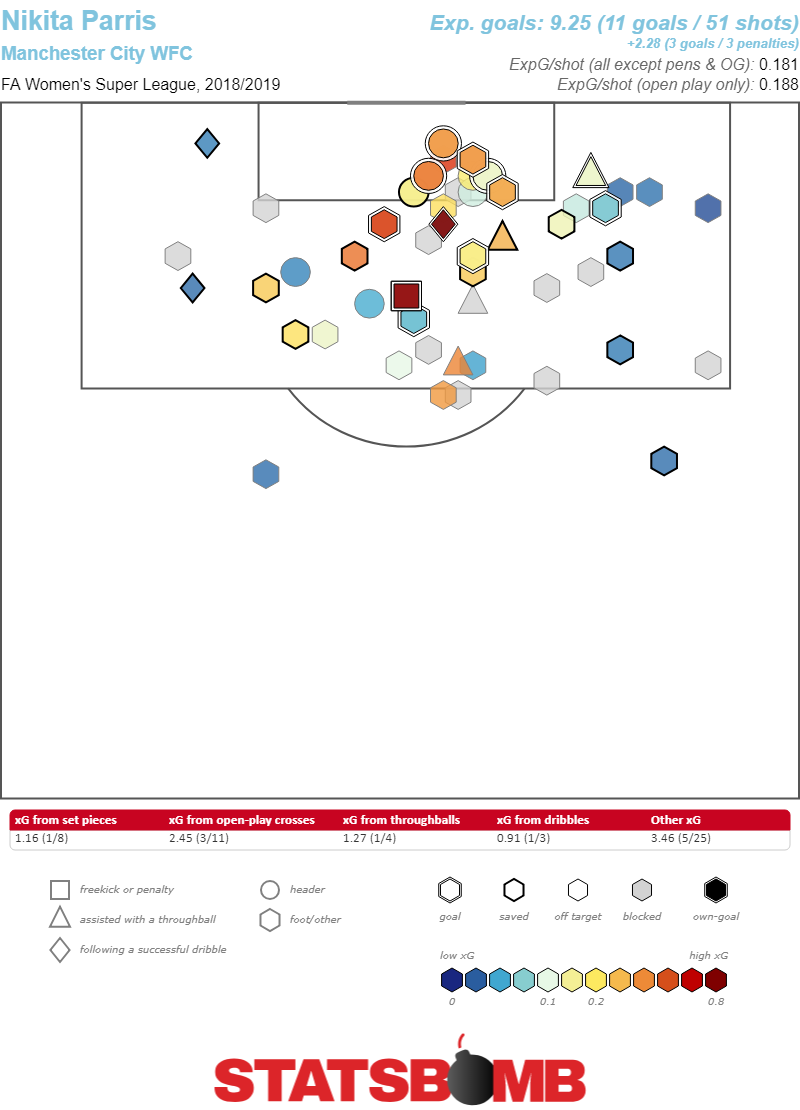 That is almost the opposite of City’s second top scorer, Georgia Stanway. Her expected goals numbers are half of her actual goal numbers, due to many shots from outside of the penalty area and non-central positions inside of the 18 yard-box. Stanway's goals might be flashier, but it's Parris's that are more likely to continue.
That is almost the opposite of City’s second top scorer, Georgia Stanway. Her expected goals numbers are half of her actual goal numbers, due to many shots from outside of the penalty area and non-central positions inside of the 18 yard-box. Stanway's goals might be flashier, but it's Parris's that are more likely to continue. 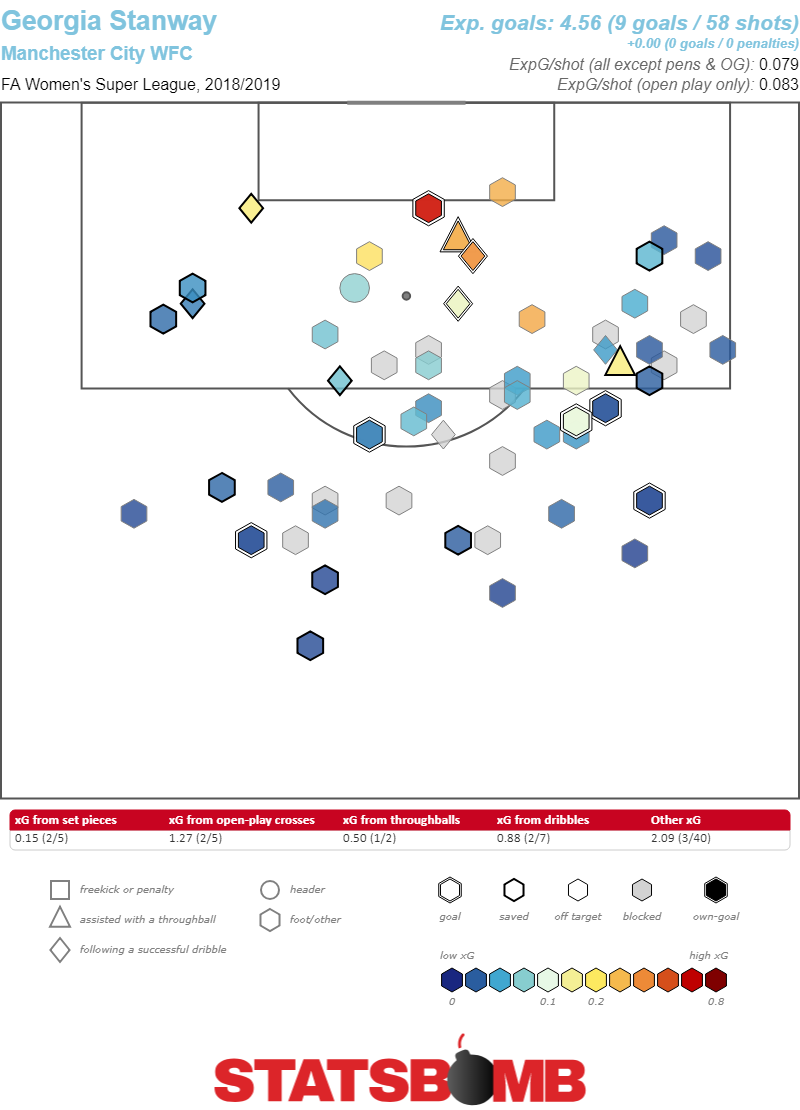 From looking at Parris’ radar below, what is impressive is that beyond offensive output, she has excellent defensive numbers, constantly pressuring the ball and winning it back.
From looking at Parris’ radar below, what is impressive is that beyond offensive output, she has excellent defensive numbers, constantly pressuring the ball and winning it back. 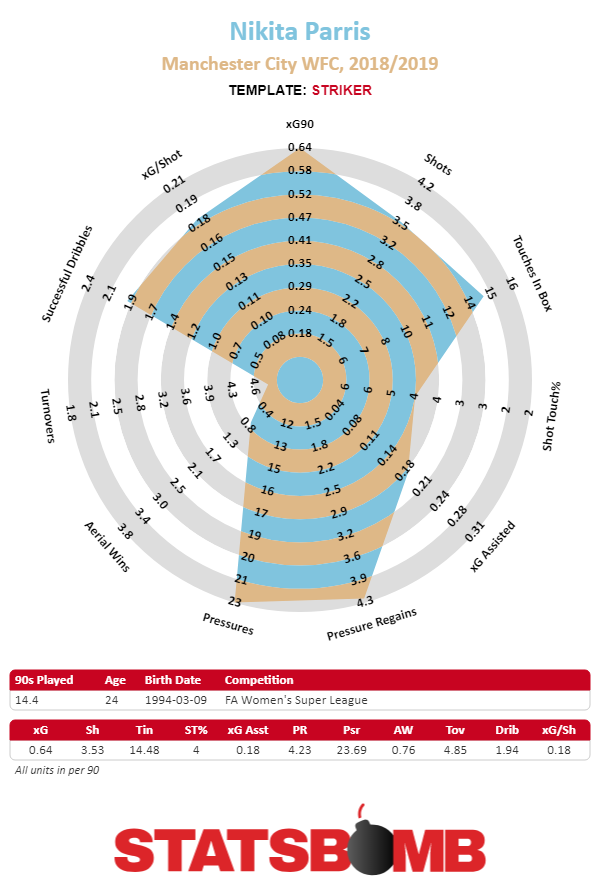 It’s easy to see why Nick Cushing has played her more centrally this season. With Manchester City looking to put opponents under pressure as high up the pitch as possible, Parris’ pace, work rate and pressing qualities are vital in order to box in opponents and start attacks close to the opponent’s penalty area. Parris's ability to lead a press has been key to Manchester City's counterpressing attacking style this season with her defensive contributions keying quick attacks. Parris haunts opponents just outside their own penalty area.
It’s easy to see why Nick Cushing has played her more centrally this season. With Manchester City looking to put opponents under pressure as high up the pitch as possible, Parris’ pace, work rate and pressing qualities are vital in order to box in opponents and start attacks close to the opponent’s penalty area. Parris's ability to lead a press has been key to Manchester City's counterpressing attacking style this season with her defensive contributions keying quick attacks. Parris haunts opponents just outside their own penalty area. 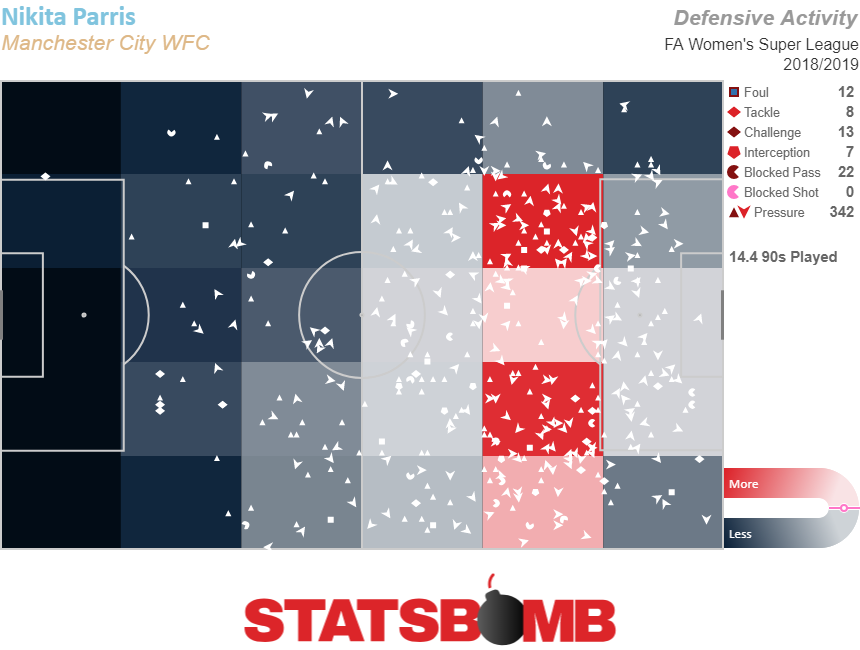 And the rest of the City squad follows suit.
And the rest of the City squad follows suit. 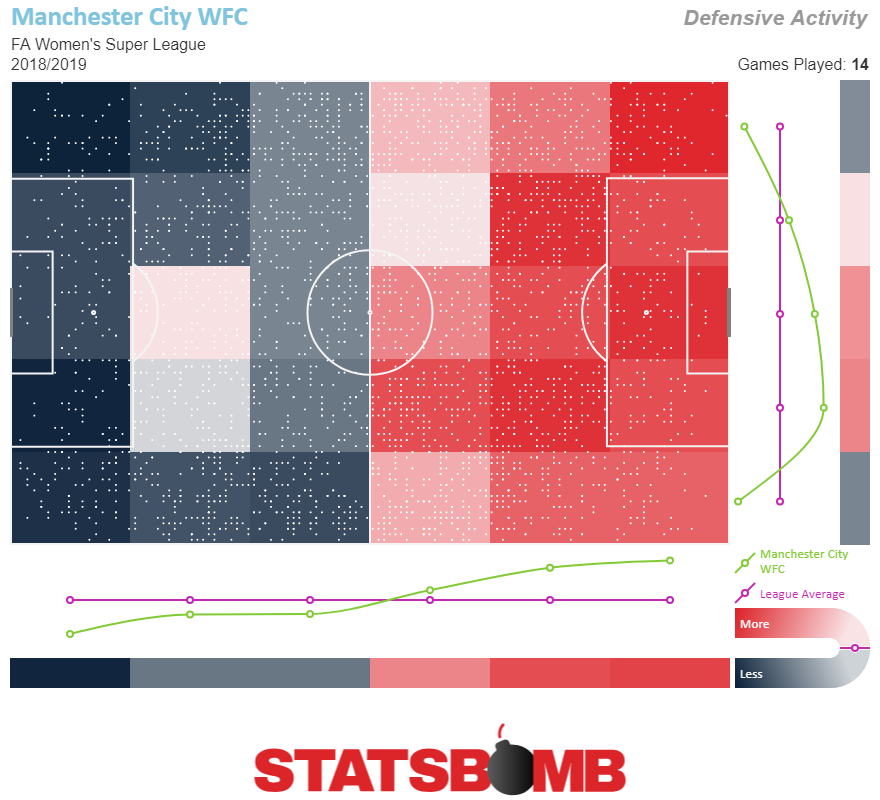 By unsettling opponents high up the pitch, City is able to create chances quickly and effectively. Parris is part of that process too. In addition to her scoring and defending contributions, she is second in the team in expected goals assisted from open play.
By unsettling opponents high up the pitch, City is able to create chances quickly and effectively. Parris is part of that process too. In addition to her scoring and defending contributions, she is second in the team in expected goals assisted from open play. 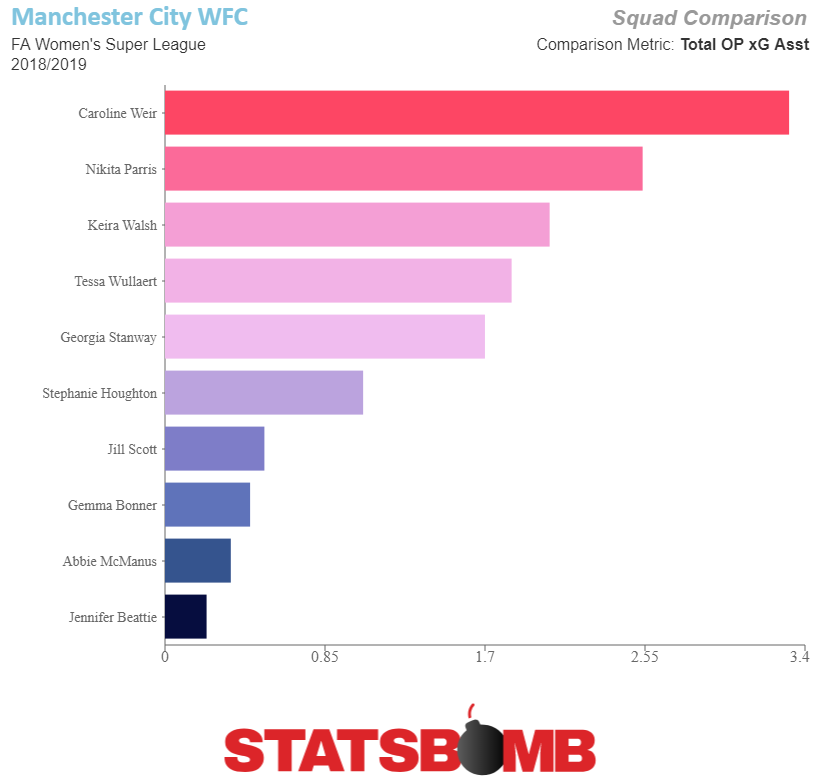 Parris is a top contributor for City in every phase of play. Her disruptive pressing wins the ball back, her passing helps others take advantage of those opportunities and her goal scoring his second to none. The combination of her stellar overall play with Weir's creative contributions and Stanway's sharp shooting is a potent mix that opposing defenses simply have not been able to stop. But, beyond just City, Parris's contributions bode well for the England's chances this summer at the World Cup. Her versatility in attack suggests that Phil Neville could depend on her to fill any number of roles if necessary. She could either facilitate the rest of England's talented attacking score, or do the bulk of the shooting and scoring herself depending on what is required. A player who is an elite attacking force, an elite defender from the front, and a stellar creator is the kind of luxury any manager dreams of being able to deploy. Parris is in an exciting battle with Miedema for the golden boot, one in which, like the title itself, could be decided on in a winner takes all heavyweight clash in May at Meadow Park. With the Continental Cup final between the two sides later on this month, Manchester City’s chances of silverware depend a lot on Parris maintaining her impressive form with and without the ball. If she can do that, and then replicate that form all summer, Parris will literally have the world at her feet. Header image courtesy of the Press Association
Parris is a top contributor for City in every phase of play. Her disruptive pressing wins the ball back, her passing helps others take advantage of those opportunities and her goal scoring his second to none. The combination of her stellar overall play with Weir's creative contributions and Stanway's sharp shooting is a potent mix that opposing defenses simply have not been able to stop. But, beyond just City, Parris's contributions bode well for the England's chances this summer at the World Cup. Her versatility in attack suggests that Phil Neville could depend on her to fill any number of roles if necessary. She could either facilitate the rest of England's talented attacking score, or do the bulk of the shooting and scoring herself depending on what is required. A player who is an elite attacking force, an elite defender from the front, and a stellar creator is the kind of luxury any manager dreams of being able to deploy. Parris is in an exciting battle with Miedema for the golden boot, one in which, like the title itself, could be decided on in a winner takes all heavyweight clash in May at Meadow Park. With the Continental Cup final between the two sides later on this month, Manchester City’s chances of silverware depend a lot on Parris maintaining her impressive form with and without the ball. If she can do that, and then replicate that form all summer, Parris will literally have the world at her feet. Header image courtesy of the Press Association
Coming into this season, the FA Women’s Super League was ready for a slug-fest between Chelsea and Manchester City.
The pair had been the dominant forces in English football since 2015, when the (London) Blues won their first WSL title and the Sky Blues were fresh off the back of their first major trophy since the injection of cash into the club’s operation*.
*NB: City fans, and former players, will be keen for it to be made clear that the club has had a women’s side since the 1980s, something which wasn’t common at the time. City and football historian Dr Gary James has done, and continues to do, work documenting this, for example.
The pair were first and second in every season from 2015 to 2018, including the WSL Spring Series that took place as the league switched from a summer to winter schedule in 2017. Arsenal, the once-premier force in the women’s game (they won nine league titles in a row between 2003 and 2012), were relegated to third-place. Perennial bronze medal winners, the new-money pair even muscling into the Gunners’ stranglehold of the FA Cup, which they have won 14 times since 1992/93.
https://twitter.com/RichJLaverty/status/1087030291926011904?ref_src=twsrc%5Etfw
But at the start of the 2018/19 season, everything seemed to have changed.
It took Chelsea four games to score their first league goal (granted, their opening match had been against City). Not long after, they were thrashed 5-0 by Arsenal, who were rolling over anything and everything in their path. Manchester City had had a slow start too, including a disappointing 2-2 draw to Bristol City.
With expected midtable clubs like Birmingham City and Reading enjoying good starts, Chelsea and City found themselves in a congested pack behind the Gunners.
Back to normality, and a three-horse race
Now, though, the league has shaken itself out. City are top by a point, albeit having played one game more than Arsenal who sit in second. Joe Montemurro’s team also have a game in hand over Chelsea, who are a further two points back in third.
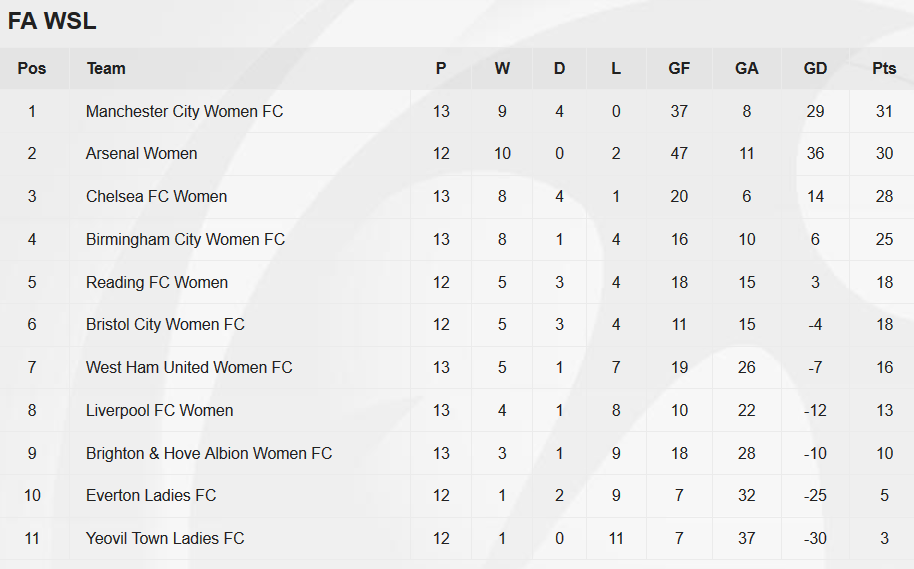
The weird thing is that each of these three teams have their own distinct story. You have Arsenal, the behemoths rearing their head after a brief slumber, a monstrous footballing phoenix. Chelsea, the slow starters. And City, the moneyed club with a stadium of their own** and a target on their back, who’ve shown rare signs of weakness.
**All 11 teams in the WSL are affiliated with a professional men’s team in the English professional leagues, but most do not share match-day facilities with them. Many play at local(ish) stadiums of a different men’s team that is in the lower professional leagues or non-league (for example, Arsenal play at Boreham Wood’s ground; Chelsea, AFC Wimbledon’s). Manchester City play at a purpose-built stadium for City’s academy and women’s teams on the club’s ‘Etihad Campus’, a couple of minutes’ walk from the main 55,000-seater Etihad Stadium. There is an argument that playing at an unfamiliar ground to fans of the club is a factor in holding back attendances, and playing on the same site as the men’s team, accessible by the same car parks and tram stop, would appear to be an advantage in encouraging a live audience for City’s women.
Arsenal
If this wasn’t professional football, everyone would have stopped playing with Arsenal because they’re too good. They’ve made whipping posts of everyone, and their performances have matched the results.
Expected goals is a stat that judges the quality of chances that teams have. The difference between Arsenal’s expected goals and their opponents’ in individual matches has given them an expected goals difference of 2.0 or more in six of their 12 league games.
It’s only once been negative once, in their recent 2-1 win over Chelsea (and even then, only just, -0.17).
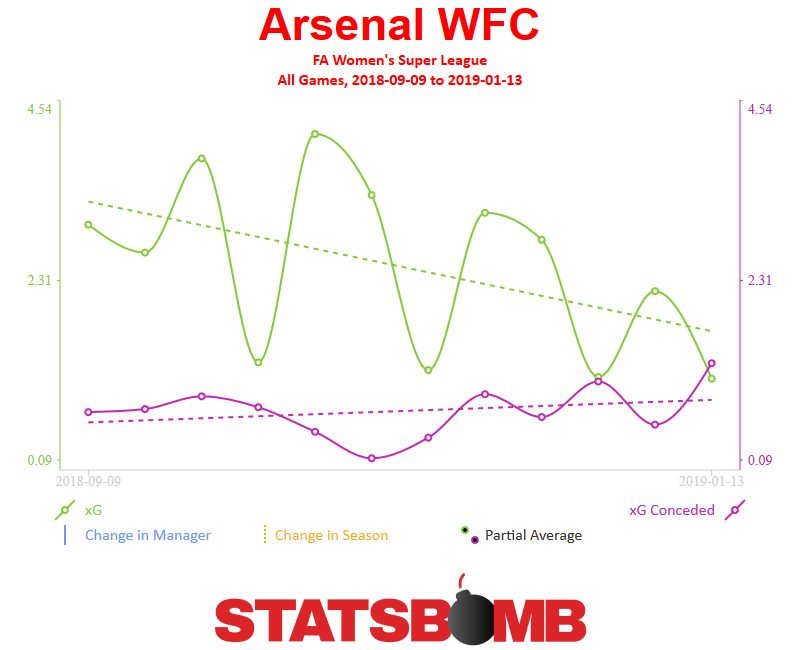
Chelsea
By rights, Chelsea should probably have enjoyed a similarly hot run of results to the Gunners though.
Emma Hayes’ team created chances worth 4.66 expected goals in their opening run of three goalless games.
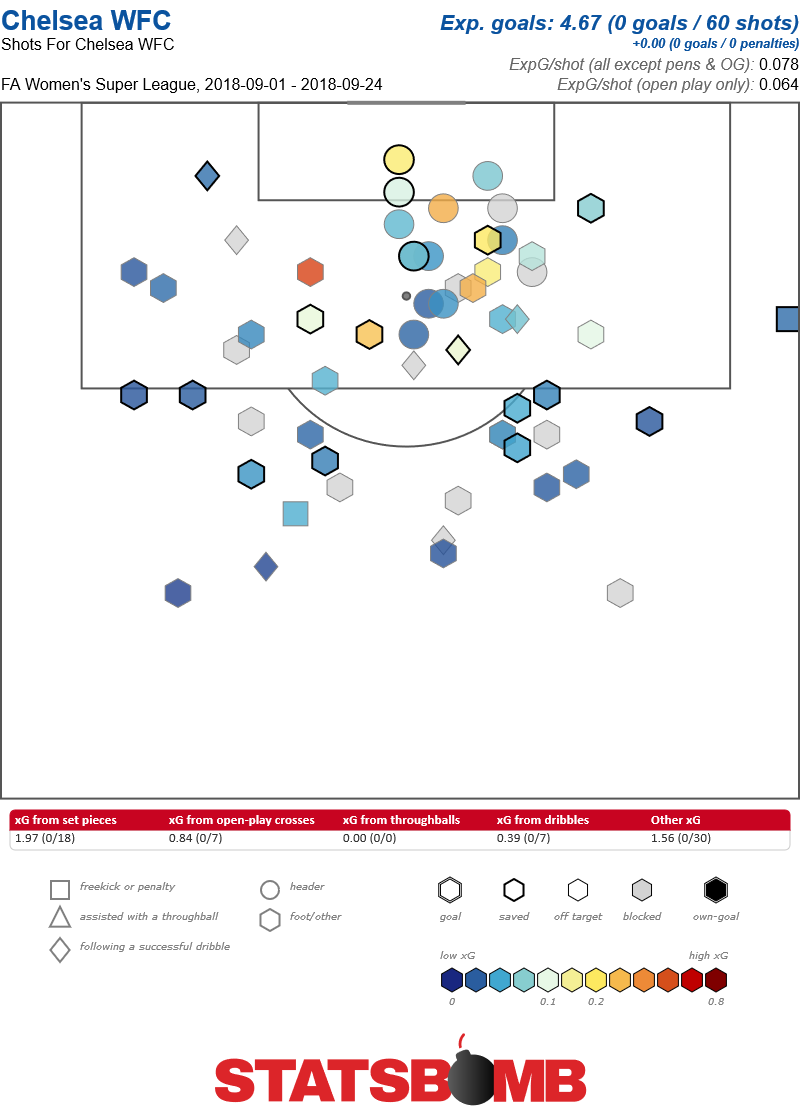
They, like Arsenal, have had six games where their expected goals total has been over two (although four of these have come in their last five). Their only games of struggle have been against the other two of the Big Three.
Manchester City, though, have genuinely struggled against the two teams in the next tier of the league, Birmingham and Reading.
Manchester City
Nick Cushing’s City have now played Birmingham - who were coached by new Orlando Pride manager Marc Skinner - home and away. City’s expected goal difference across the two games against the Midlands side is just +0.45. Chelsea and Arsenal both beat that in one match.
Similarly, when City drew 1-1 against Reading, the expected goal scoreline read 1.56-1.08; in other words City created more, but only just, and a draw was a reasonable result. Meanwhile Chelsea won their only meeting with the Royals so far 1-0, though expected goals suggests the scoreline could have been much larger, and Arsenal deservedly whomped Reading 6-0. Looking at expected goals created per match against other top five teams, City has clearly one much less in attack than their two competitors for the league.
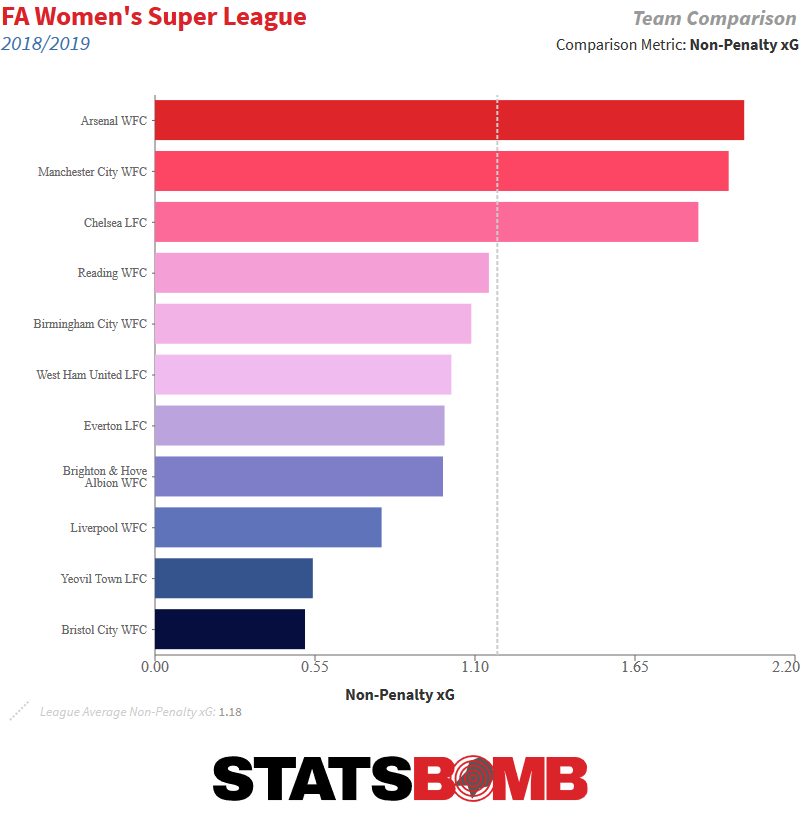 Fans of City will be bemoaning these performances, but fans of women’s football as a whole will probably be encouraged. Birmingham and Reading are proving that it’s not just the big guns, backed by copious amounts of money, who can compete (Durham, one of the few teams to halt Manchester United’s dominance of the second-tier, the FA Women’s Championship, are an encouraging example of this too).
Fans of City will be bemoaning these performances, but fans of women’s football as a whole will probably be encouraged. Birmingham and Reading are proving that it’s not just the big guns, backed by copious amounts of money, who can compete (Durham, one of the few teams to halt Manchester United’s dominance of the second-tier, the FA Women’s Championship, are an encouraging example of this too).
The title race
The three teams are clear behemoths at the top of the league and, with the table so tight, every match counts.
This weekend sees Arsenal travel to Reading and Chelsea host Birmingham (under new manager Marta Tejedor); City will be hoping that the WSL middle-class will slow their rivals down. It isn’t long until the next crunch match at the top either, with the Manchester side due to welcome Chelsea on February 10.
The final game of the top three mini-league, Arsenal vs City, is scheduled for the last day of the season. It could well be a title-decider. It could well, if the edge that the Gunners’ underlying numbers are to be believed, be Arsenal’s first league title since 2012.
The WSL is the title race you should be keeping an eye on.
Header image courtesy of the Press Association
Football is a team game, but every team is made up of individuals. And if there’s one thing about fans, it’s that we love individual players to rally behind. And there are plenty to choose from up and down the Women’s Super League. From Arsenal, running away with the league; to recent champions Manchester City and Chelsea, as well as Birmingham City and Reading, in the chasing pack; down to struggling teams at the bottom like Brighton, Yeovil, and Everton. Here are some of the best picks from StatsBomb’s WSL data.
(Ed. note- as always please allow for some data lag in our analysis. Specifically the Manchester City v West Ham match is currently not in our data set, therefore crediting Georgia Stanway with two fewer goals than her actual seven)
Youngsters tearing up the league
WSL is blessed by some great young wingers. Two are on Merseyside, Liverpool’s Rinsola Babajide and Everton’s Chloe Kelly are first and third in the league for successful dribbles per 90 minutes. Babajide is averaging over four, literally off the charts on our radars, so woe betide any full-back coming up against her. 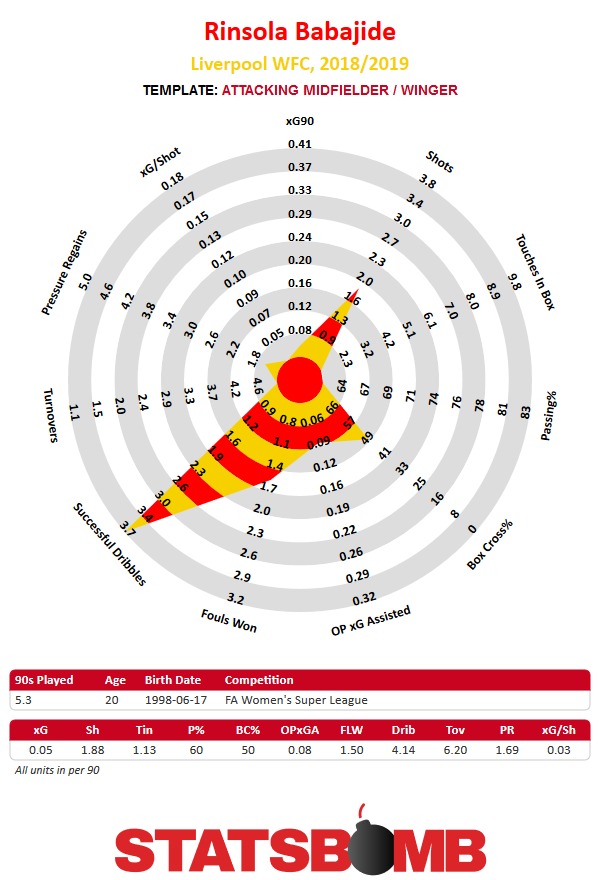
Between Babajide and Kelly is Manchester City’s Caroline Weir. Weir consistently terrorises the right-side of opponent defences, averaging 3.15 dribbles per 90 minutes. She has three goals to her name already, including a superb strike against West Ham United (a reward for some otherwise slightly errant shot selection that sees her shots average just a six per cent chance of going in).
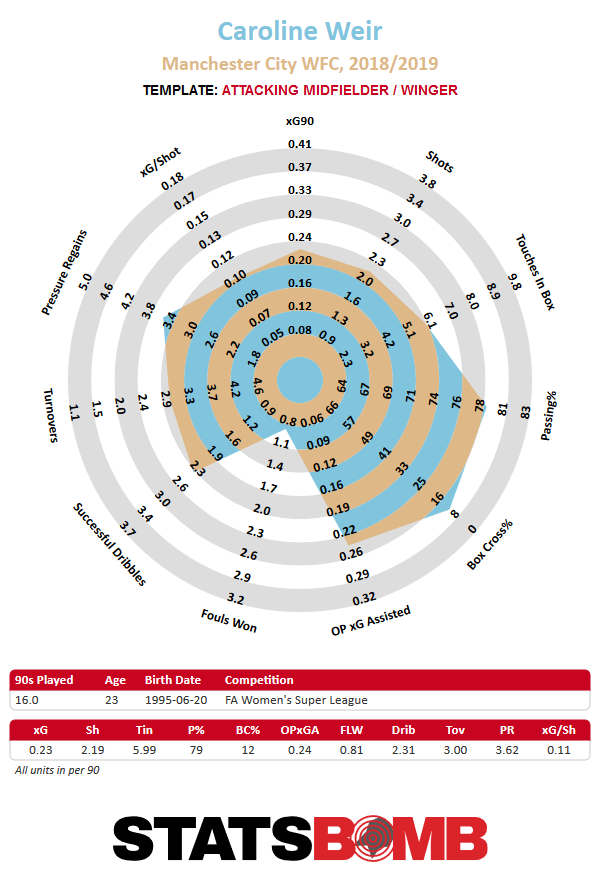
At the moment, she’s off the charts for the quality of chances that she sets up. They’re worth over 0.34 expected goals per 90 minutes that she plays - or one assist for every three full games. Only two other players in the league - Beth Mead at Arsenal and Gemma Davison at Reading - do better.
Working hard on the wing
It’ll usually be players at the top teams who dominate statistical categories - and we’re going to see some real heavyweight examples of that later on - but there’s a lot of incredibly hard work going on across the WSL. Ellie Brazil at Brighton leads the league for pressure events per 90 minutes, locking down the right flank (defending the goal to the left of the graphic).
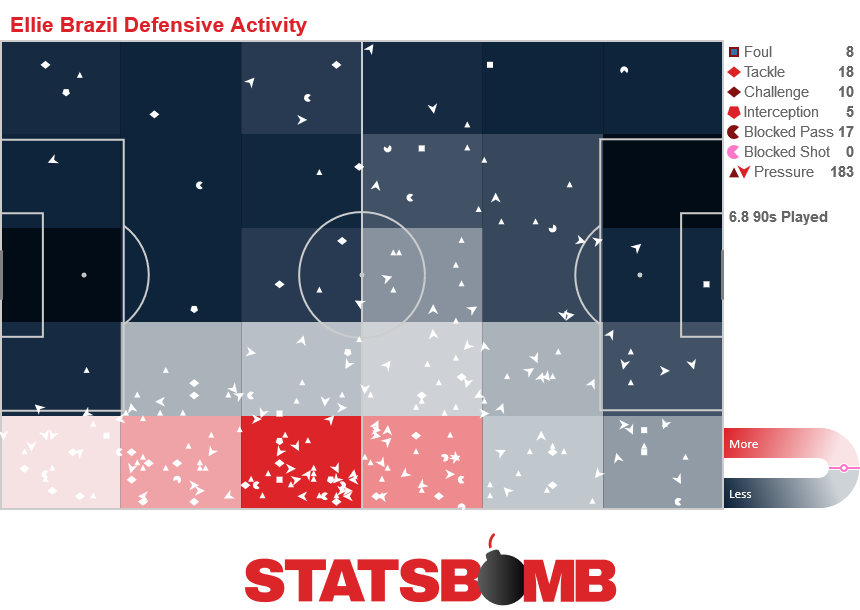
Just behind her, and on the opposite flank, is Ella Rutherford at Bristol City. At 19 and 18 respectively, Brazil and Rutherford are putting in hard yards for their team and getting experience that will serve them well in the future.
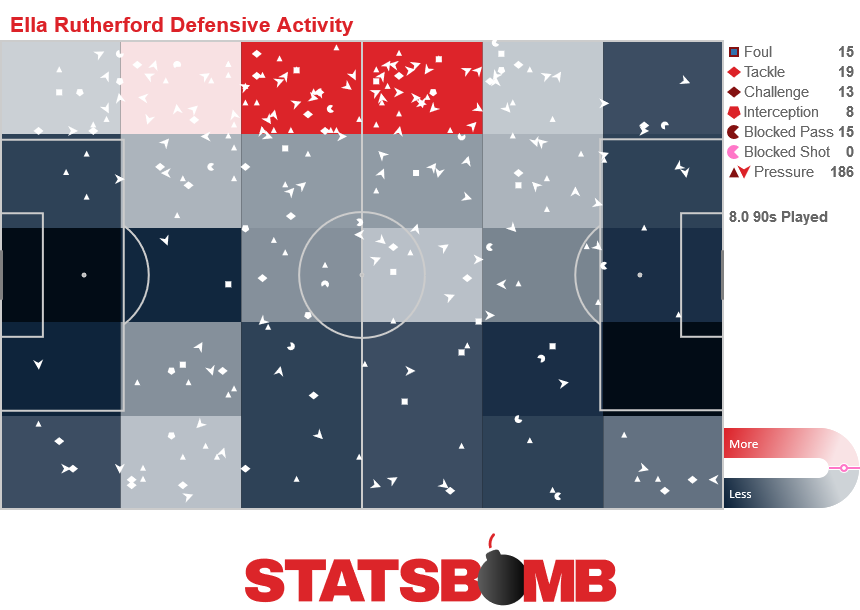
Dominating the middle
Chasing down opponents isn’t just for teenagers though. Behind the two whippersnappers, and leading the way for pressures that lead to her team getting the ball, is Manchester City’s Jill Scott. Scott’s been at the top of the game for over a decade, winning her first England cap back in 2006, and is still a hell of a midfielder. She’s arguably the best defensive midfielder in the WSL. Running her close, though, is Arsenal’s summer Swiss signing Lia Wälti. Wälti makes an impressive amount of tackles and interceptions considering how much of the ball the Gunners have, and, once she gets it, she moves it forward towards goal as well. The combination of defensive actions and successful dribbles make her a very important part of the team.
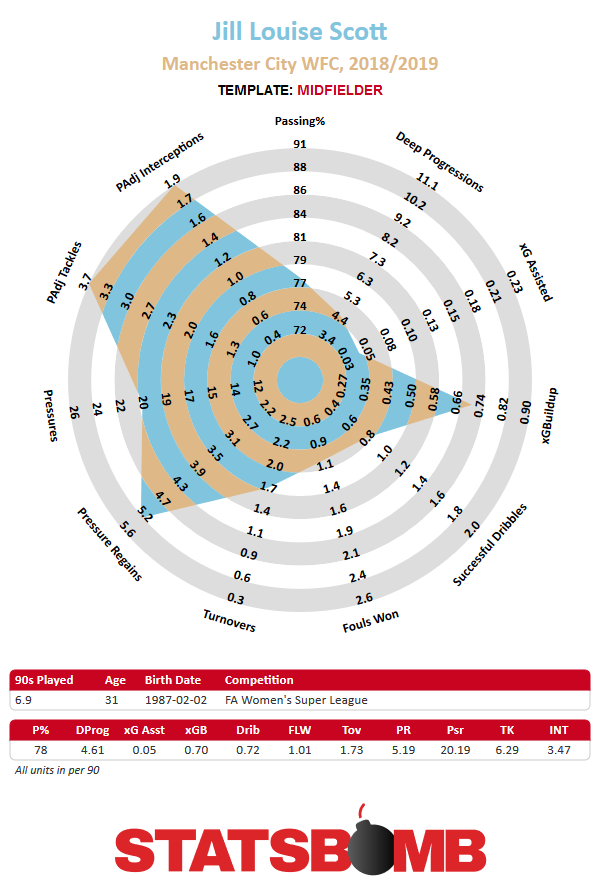
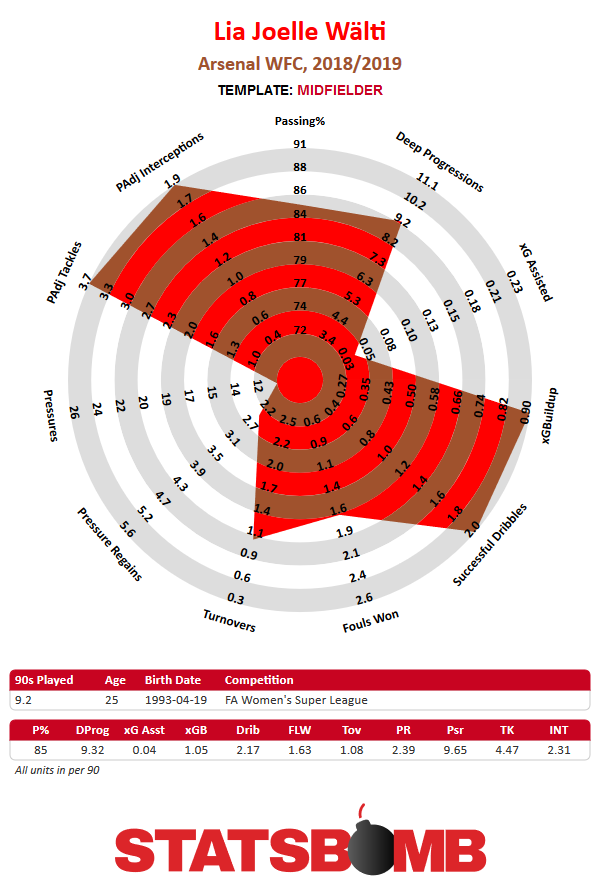
Safe hands
While we’re speaking about crucially important parts of the team, it makes sense to mention Ann-Katrin Berger, Birmingham City’s goalkeeper. As things currently stand, the Blues are third in the league, just two points behind Manchester City and three points ahead of WSL holders Chelsea. Berger’s part in that can’t be understated - out of WSL’s starting goalkeepers she leads the way for saves above expectation.
Taking into account the quality of shots she’s faced, she’d be expected to save 69.9 per cent of them; in actual fact, she’s saved 82.8 per cent. Is there anything opponents can do to improve their chances? StatsBomb’s data suggests there might be a couple of holes low to her right or high to her left...
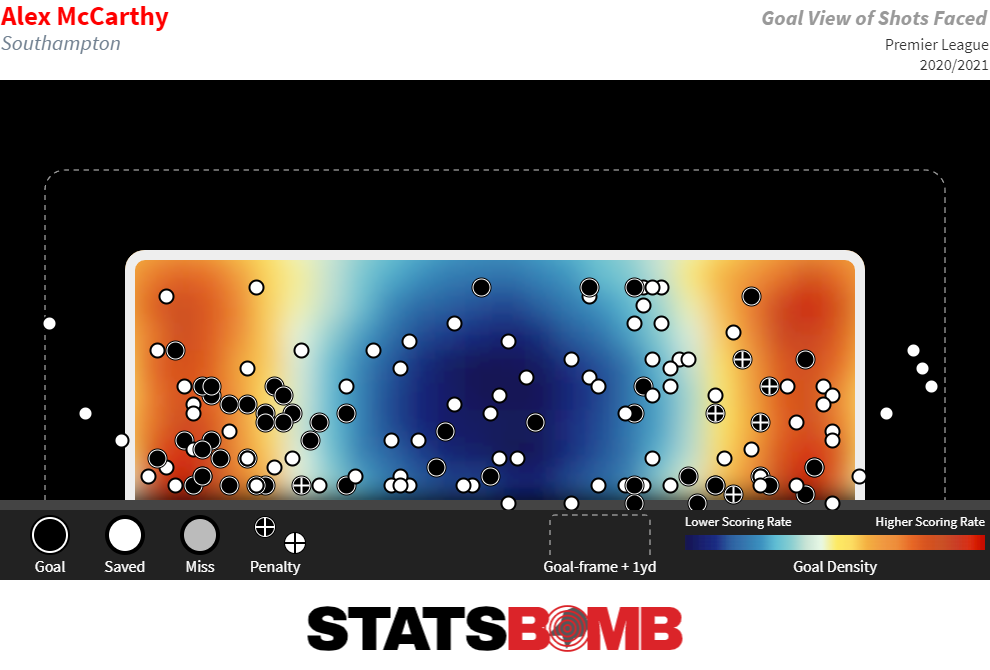 Racking up goals like no tomorrow
Racking up goals like no tomorrow
Not that Vivianne Miedema or Nikita Parris would need help scoring goals. The pair are extraordinarily good, both in terms of volume and quality of chances that they get on the end of (although being on teams as good as Arsenal and City certainly helps). The amount of pressure that Parris applies on opponents embodies defending from the front.
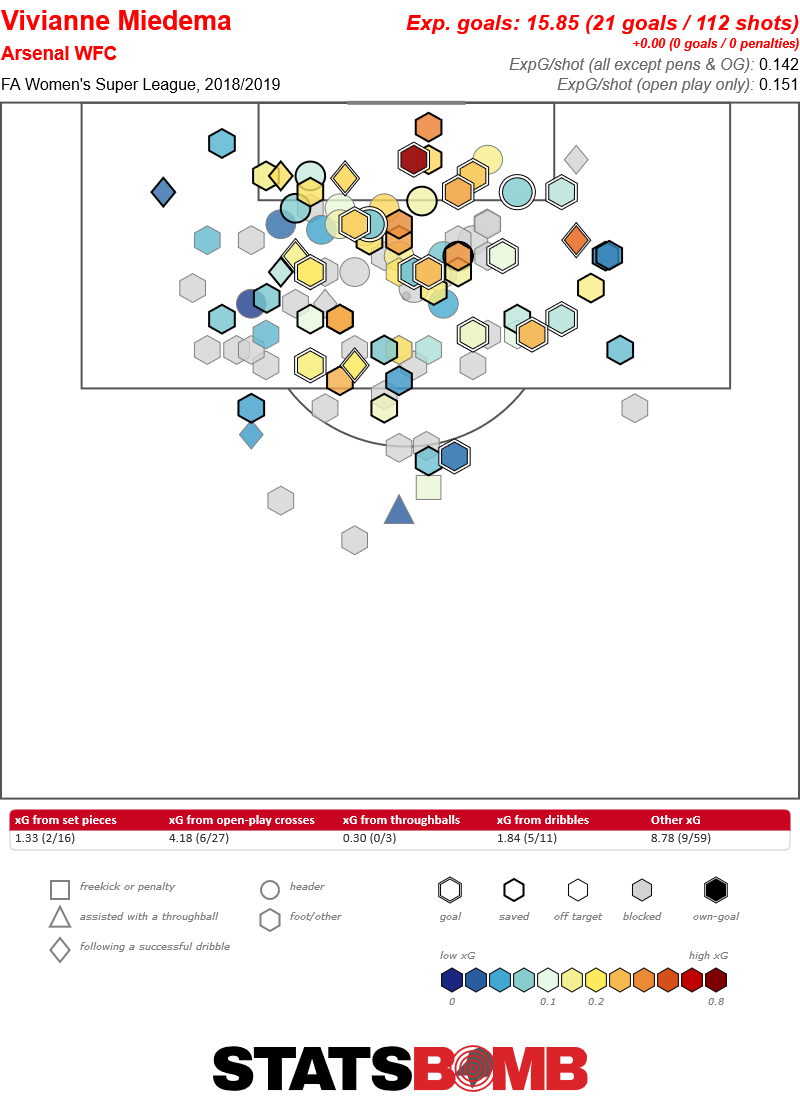
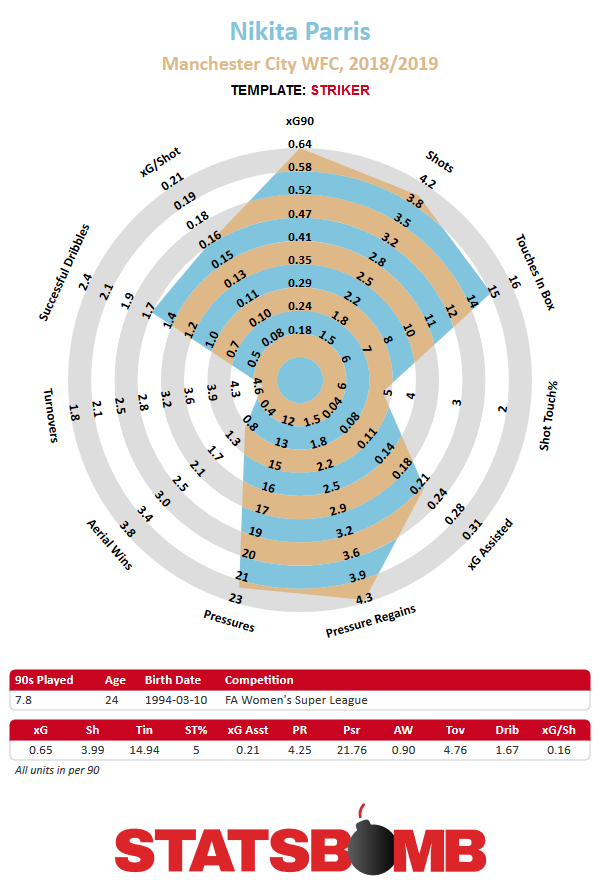
Parris’ team-mate Georgia Stanway has also been amongst the goals recently, although who knows whether it’ll last. She’s scored more than double what her expected goals would think, with a shot map that’s almost the exact opposite of Parris’.
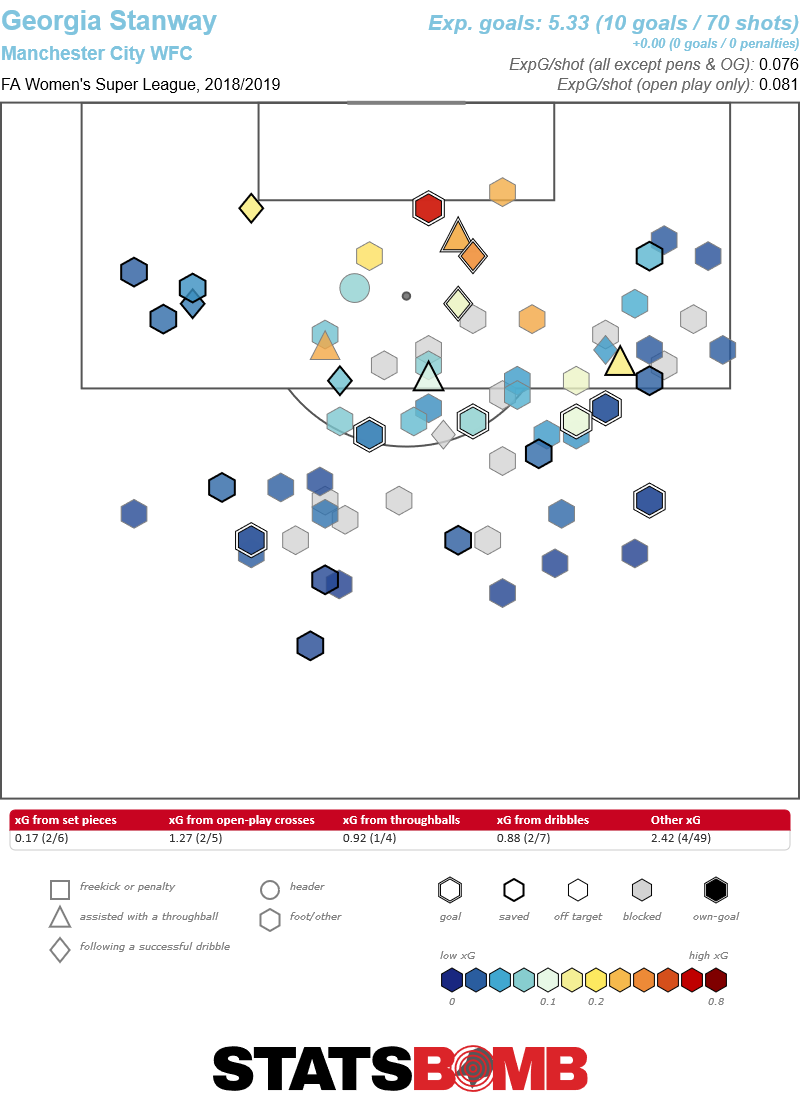

Across the entire league there are some cracking players to be excited about, and there’s just over half of the WSL left to go. Get yourself down to a game.
The first professional women’s match I attended in person was the 2010/11 Champions League Final between Lyon and Turbine Potsdam.
A few rows in front sat Trevor Brooking and Michel Platini.
Yeah, I didn’t slum it for my first game.
It was a great match with the technical French side winning 2-0 against the more physical Germans. Three things stood out. Firstly, Potsdam No 10 Fatmire Bajramaj, still one of the best technical players I’ve ever seen in the flesh. Secondly, Lyon substitute Lara Dickenmann’s half-time warm up that would’ve given a Ronaldinho trick show a run for its money. And lastly, but not erm, leastly, Sarah Bouhaddi, Lyon’s goalkeeper.
Man, was she good.
She effortlessly plucked every cross out of the air and was comfortable with the ball at her feet. Bouhaddi made a Champions League Final look like a training session. The last professional women’s match I attended in person was last week’s FA Women’s Super League (FAWSL) game between West Ham and Chelsea. The Irons’ keeper Becky Spencer was given player of the match and certainly deserved it having made three great saves in the first half alone. Watch them here.
It’s all a little bit odd as every time I speak to any male friends (who barely watch women’s football) they immediately raise the state of the goalkeeping as being terrible…
The guys at Statsbomb have started collecting data on the FAWSL and the National Women’s Soccer League in the United States this year. Now, the data set is still waaaaay too small to conclude anything but imagine my delight on discovering that so far, when you lay a shooting model from the professional men’s’ game over the women’s data, the goalkeepers in women’s football are performing better than their male counterparts. They’re breaking the model.
As the data gets gathered I felt it was a nice time to get some views from within the game itself. Andy Elleray is goalkeeping coach at Birmingham City Women and is England Women’s Youth International goalkeeping coach too. Do his coaching sessions for women look different to ones he coaches for men? What differences must be accounted for?
“The sessions don’t look amazingly different to be honest,” says Elleray. “It’s all based around the keepers you’re working with and the way the club wants them to play. In terms of attributes, female keepers are not as powerful so lots of work is done on jumping mechanics, speed to cover the goal and defend the area. Distribution is a big area for us and the goalkeepers must be able to play with variation - especially in our half of the pitch. The length that females can strike a ball is more often than not shorter than males so we look for our goalkeepers to play what we call PACE (positively, accurately, consistently and effectively) rather than rely on hitting areas and turning the opposition defence."
The data collected so far backs these statements up. Only Sophie Baggaley at Bristol City and Megan Walsh at Yeovil relentlessly go long. Here’s what Birmingham keeper Ann-Katrin Berger’s distribution looks like:

“With the role of the goalkeeper ever evolving I can see more statistics based around distribution,” says Elleray. “I have developed my own distribution analysis that I use at various points to assess how well we are retaining the ball or penetrating the opposition.”
Lloyd Yaxley, goalkeeping coach at NWSL club Orlando Pride is in agreement. “I think there will definitely be statistical differences between the men's and women's data. With distribution, the male goalkeepers’ range of passing is for the most part significantly longer than in the women's game. I think if you were to take something as simple as a long goal kick and compare the average length of a Major League Soccer goalkeeper to a NWSL goalkeeper there would probably be at least a 15-20 yard difference.”
Despite this, Yaxley states that like Elleray, his sessions for men and women don’t look that different. “I try and keep my philosophies towards the role of the goalkeeper as set as I can and how I want my goalkeepers to perform wouldn't change all that much. I would want them to be aggressive in certain situations and then in other areas less aggressive and maybe play deeper in their goal. With shot stopping I like my goalkeepers to be deeper so to allow for more reaction time - especially when there are a lot of bodies in front - this I would keep the same for males and females.”
Yaxley thinks having the ability to parry into safe areas is a significant attribute to have and is working to bring this to the women’s game as standards continually rise. “Men are used to the ball being struck at greater pace and therefore with greater movement too. We work on this with the Pride goalkeepers - especially if it’s a reaction exercise or I connect with a strike really well then we look at manipulating the body to best control the rebound. For example, when the ball is struck at pace and straight at you, rotating wrists and leaning with the shoulders late forces the ball into a wide area. If the lean of the shoulders comes too early, the control of where the ball ends up is often lost.”
How much does data influence training at present?
“I don’t really use data on a daily basis, but the higher you go at international level there is lots of work done on goalkeeper specific stats throughout the teams to analyse, review and compare keepers,” says Elleray. “I have written lots of research on goalkeepers from various view points and am a massive advocate of using video analysis throughout the coaching process. Recently there has been clubs using GPS data to measure goalkeeper training load and different types of movements and this is an area that I will be moving more towards. At any turn statistics should be used to aid the process not take it over."
Yaxley uses numbers in a different way.
“The main data I analyse is where the opposition is shooting from and scoring from and on the flip side, where we are conceding shots from and conceding goal from. We look at opposition trends and their style of play, danger players’ traits - do they like to cut in from the left and shoot with their right, are they getting to the line and cutting it back, for example. That will all help shape my focus for the weeks training.”
The level of detail StatsBomb collects at goalkeeping level now would aid such a process, and enable quicker analysis of your own players too. You’ve all seen the shot maps on site by now but there’s some cool new stuff deeper under the hood:


We’ve never been able to dive down and get dirty to this degree until now. As one keeping coach I follow on twitter is fond of saying…I’m #alloverit Header image courtesy of the Press Association
